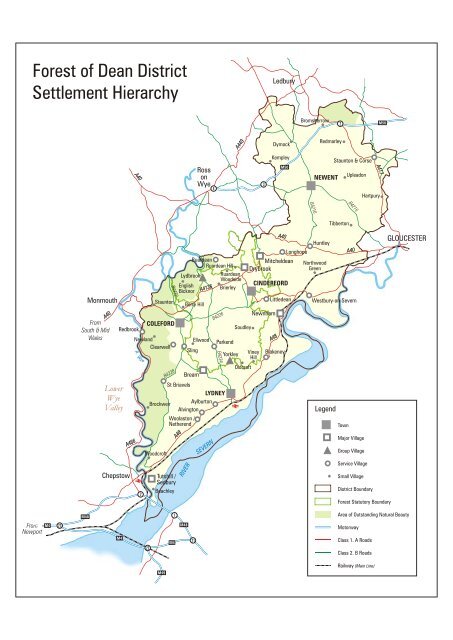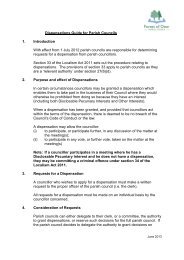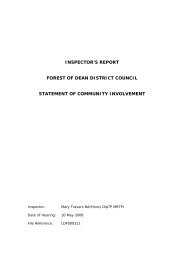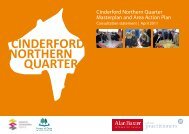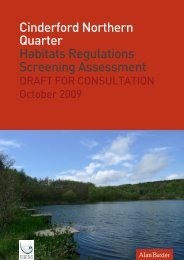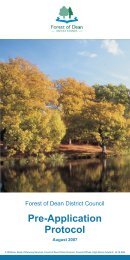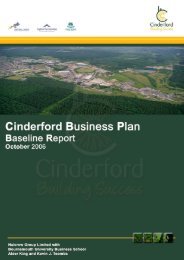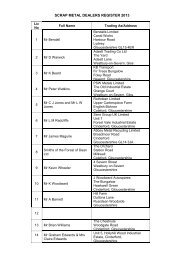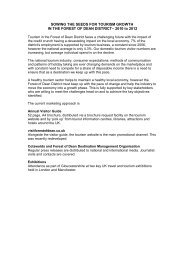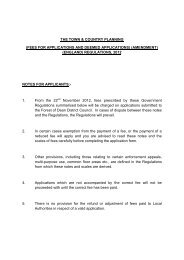Settlement Hierarchy for the Forest of Dean - Forest of Dean District ...
Settlement Hierarchy for the Forest of Dean - Forest of Dean District ...
Settlement Hierarchy for the Forest of Dean - Forest of Dean District ...
You also want an ePaper? Increase the reach of your titles
YUMPU automatically turns print PDFs into web optimized ePapers that Google loves.
<strong>Forest</strong> <strong>of</strong> <strong>Dean</strong> <strong>District</strong> Council | <strong>Settlement</strong> <strong>Hierarchy</strong> <strong>for</strong> <strong>the</strong> <strong>Forest</strong> <strong>of</strong> <strong>Dean</strong><br />
Contents<br />
1 Background 2<br />
2 Introduction 4<br />
3 What is a <strong>Settlement</strong> <strong>Hierarchy</strong> 5<br />
4 What is <strong>the</strong> role <strong>of</strong> <strong>the</strong> planning system 6<br />
5 The Current Situation 7<br />
6 National Policy 8<br />
7 Regional Policy 9<br />
8 Methodology 11<br />
9 Market Towns 14<br />
10 Lydney 15<br />
11 Cinder<strong>for</strong>d 17<br />
12 Cole<strong>for</strong>d 18<br />
13 Newent 20<br />
14 O<strong>the</strong>r <strong>Settlement</strong>s 21<br />
15 Conclusion 26<br />
16 Relevant Strategic Policies 27<br />
17 Comparative Matrix <strong>of</strong> Services & Facilities in <strong>the</strong> <strong>Forest</strong> <strong>of</strong> <strong>Dean</strong><br />
<strong>Settlement</strong>s 41
<strong>Forest</strong> <strong>of</strong> <strong>Dean</strong> <strong>District</strong> Council | <strong>Settlement</strong> <strong>Hierarchy</strong> <strong>for</strong> <strong>the</strong> <strong>Forest</strong> <strong>of</strong> <strong>Dean</strong><br />
1 . Background<br />
1 Background<br />
1.1 The <strong>Forest</strong> <strong>of</strong> <strong>Dean</strong> <strong>District</strong> is situated between <strong>the</strong> River Severn and <strong>the</strong> River<br />
Wye and is largely rural in character. The <strong>District</strong> has four main towns: Cinder<strong>for</strong>d,<br />
Cole<strong>for</strong>d, Lydney and Newent.<br />
1.2 Cinder<strong>for</strong>d is located in <strong>the</strong> heart <strong>of</strong> <strong>the</strong> <strong>Forest</strong> <strong>of</strong> <strong>Dean</strong> and is closely related<br />
to <strong>the</strong> settlement <strong>of</strong> Ruspidge, with a combined population <strong>of</strong> around 10,000. Heavy<br />
industry has had a significant influence on <strong>the</strong> development <strong>of</strong> <strong>the</strong> area and this<br />
legacy is particularly strong in Cinder<strong>for</strong>d and Ruspidge. Most <strong>of</strong> <strong>the</strong> existing town<br />
dates back to <strong>the</strong> late eighteenth, nineteenth and twentieth centuries, and <strong>the</strong> town<br />
still has a strong manufacturing base. The area has a number <strong>of</strong> problems to solve<br />
but equally has opportunities to exploit and <strong>the</strong> town and surrounding area is at an<br />
important stage in its development.<br />
1.3 Cole<strong>for</strong>d is an attractive historic market town at <strong>the</strong> western edge <strong>of</strong> <strong>the</strong> <strong>Forest</strong><br />
<strong>of</strong> <strong>Dean</strong>, approximately 16km north <strong>of</strong> Chepstow. Whilst <strong>the</strong> town is relatively small<br />
(having a population <strong>of</strong> approximately 6,000), it is closely related to a group <strong>of</strong><br />
settlements, including Milkwall, Mile End and Coalway, which effectively doubles its<br />
population. The town is large enough to support a wide range <strong>of</strong> services and<br />
shopping facilities and it is <strong>the</strong> second largest shopping centre in <strong>the</strong> <strong>District</strong>. Heavy<br />
industry has had a significant influence on <strong>the</strong> development <strong>of</strong> <strong>the</strong> area and <strong>the</strong> area<br />
has been generally <strong>for</strong>tunate to escape <strong>the</strong> legacy <strong>of</strong> dereliction, which affects many<br />
o<strong>the</strong>r post-industrial locations. Cole<strong>for</strong>d has an attractive and historic core and lies<br />
in a bowl surrounded by open countryside, which has meant that <strong>the</strong>re have been<br />
few opportunities <strong>for</strong> expansion without losing this valuable asset. Cole<strong>for</strong>d lies close<br />
to <strong>the</strong> Wye Valley Area <strong>of</strong> Outstanding Natural Beauty and <strong>the</strong> town benefits from<br />
visiting tourist activity. Heavy industrial activity has almost ceased, leaving Cole<strong>for</strong>d<br />
and its surrounding area to develop, expand and adapt its role as a market town<br />
providing shopping and o<strong>the</strong>r services to its hinterland.<br />
1.4 Lydney is <strong>the</strong> most sou<strong>the</strong>rly <strong>of</strong> <strong>the</strong> four main <strong>Forest</strong> towns. It is accessible<br />
by train, situated on a route between South Wales and <strong>the</strong> Midlands, and <strong>the</strong> A48<br />
trunk road connects <strong>the</strong> town to Chepstow and Gloucester. The town has an attractive<br />
settling between <strong>the</strong> <strong>Forest</strong> and <strong>the</strong> Severn Valley. Historically, <strong>the</strong> town was a port<br />
<strong>for</strong> <strong>the</strong> <strong>Forest</strong> <strong>of</strong> <strong>Dean</strong> area, especially <strong>for</strong> exporting raw materials such as stone,<br />
coal, and iron and timber until <strong>the</strong> demise <strong>of</strong> those industries. It also acted as an<br />
agricultural market town including a river-based economy and developed<br />
manufacturing skills to serve <strong>the</strong> surrounding countryside. The manufacturing tradition<br />
was stimulated by <strong>the</strong> mining and docking industries and <strong>the</strong> railway led to <strong>the</strong><br />
manufacturing base broadening fur<strong>the</strong>r. However, Lydney has followed <strong>the</strong> national<br />
trend <strong>of</strong> <strong>the</strong> decline in <strong>the</strong> mining and manufacturing sectors, and infrastructural<br />
changes to agriculture and retail. The town currently has a population <strong>of</strong> around<br />
8,000.<br />
2
<strong>Forest</strong> <strong>of</strong> <strong>Dean</strong> <strong>District</strong> Council | <strong>Settlement</strong> <strong>Hierarchy</strong> <strong>for</strong> <strong>the</strong> <strong>Forest</strong> <strong>of</strong> <strong>Dean</strong><br />
1 . Background<br />
1.5 Newent is a small traditional market town in <strong>the</strong> north <strong>of</strong> <strong>the</strong> <strong>Forest</strong> <strong>of</strong> <strong>Dean</strong><br />
<strong>District</strong> and is located approximately 15km from Gloucester. Newent is smaller than<br />
<strong>the</strong> o<strong>the</strong>r three main <strong>Forest</strong> towns with a population <strong>of</strong> around 4,500. Newent has<br />
an ancient history and is thought to have Roman origins. The medieval street pattern<br />
and <strong>the</strong> central market place are two <strong>of</strong> <strong>the</strong> town’s most attractive features. The<br />
countryside surrounding <strong>the</strong> town provides high quality agricultural land with<br />
medium-sized farms specialising in dairying, fruit growing, and horticulture, toge<strong>the</strong>r<br />
with <strong>for</strong>estry. The landscape is characterised by gently rolling land with small villages<br />
and scattered settlements within it. Newent has a high quality built environment,<br />
which was designated as a conservation area in 1979. Today, <strong>the</strong> town remains an<br />
important service centre <strong>for</strong> <strong>the</strong> surrounding settlements providing a wide range <strong>of</strong><br />
leisure, entertainment, welfare, education and retail facilities, as well as acting as a<br />
focus <strong>for</strong> tourism within <strong>the</strong> nor<strong>the</strong>rn part <strong>of</strong> <strong>the</strong> <strong>Forest</strong> <strong>of</strong> <strong>Dean</strong>.<br />
1.6 Outside <strong>of</strong> <strong>the</strong> four main towns, individual settlements vary considerably from<br />
one part <strong>of</strong> <strong>the</strong> <strong>District</strong> to ano<strong>the</strong>r. Most <strong>of</strong> <strong>the</strong> smaller settlements have strong<br />
interconnections with o<strong>the</strong>r small settlements, with one <strong>of</strong> <strong>the</strong> four main towns and/or<br />
one <strong>of</strong> <strong>the</strong> larger settlements outside <strong>of</strong> <strong>the</strong> <strong>District</strong> (e.g. Gloucester or Chepstow).<br />
1.7 The individual settlements display <strong>the</strong>ir own development layout characteristics<br />
and <strong>for</strong>m. Generally in <strong>the</strong> north <strong>the</strong>y are compact and have clear physical boundaries<br />
with areas <strong>of</strong> ribbon development adjoining some. In <strong>the</strong> south many <strong>of</strong> <strong>the</strong> villages<br />
outside <strong>the</strong> <strong>Forest</strong> Ring have developed from small hamlets and are relatively<br />
concentrated built up areas within agricultural landscapes. The <strong>Forest</strong> Ring comprises<br />
an almost continuous <strong>for</strong>m <strong>of</strong> built development encircling <strong>the</strong> core woodlands <strong>of</strong> <strong>the</strong><br />
<strong>Forest</strong> <strong>of</strong> <strong>Dean</strong> and <strong>the</strong> minerals outcrop (coal, metal ores, and stone) that generally<br />
coincides with <strong>the</strong> perimeter <strong>of</strong> <strong>the</strong> <strong>Forest</strong>. A large number <strong>of</strong> <strong>the</strong>se <strong>Forest</strong> Ring<br />
villages are dominated by a distinctive settlement pattern in <strong>the</strong> <strong>for</strong>m <strong>of</strong> loosely<br />
aggregated communities with <strong>the</strong> presence <strong>of</strong> open areas in <strong>the</strong> <strong>for</strong>m <strong>of</strong> <strong>for</strong>est waste<br />
and paddocks. This pattern is very different from <strong>the</strong> more traditional <strong>for</strong>ms <strong>of</strong> villages<br />
found in o<strong>the</strong>r parts <strong>of</strong> <strong>the</strong> <strong>District</strong>.<br />
3
<strong>Forest</strong> <strong>of</strong> <strong>Dean</strong> <strong>District</strong> Council | <strong>Settlement</strong> <strong>Hierarchy</strong> <strong>for</strong> <strong>the</strong> <strong>Forest</strong> <strong>of</strong> <strong>Dean</strong><br />
2 . Introduction<br />
2 Introduction<br />
2.1 The Local Development Framework (LDF) must carefully consider <strong>the</strong> options<br />
<strong>for</strong> a settlement hierarchy. The LDF Core Strategy document is expected to have<br />
considered and finalised <strong>the</strong> options available to <strong>the</strong> district, having regard to national<br />
and regional policy guidance and local factors.<br />
2.2 The role <strong>of</strong> this paper is <strong>the</strong>re<strong>for</strong>e to;<br />
Explain <strong>the</strong> role <strong>of</strong> national and regional policies in <strong>the</strong> hierarchy<br />
Provide background evidence <strong>for</strong> a settlement hierarchy<br />
2.3 The settlement hierarchy is important as <strong>the</strong> Local Development Framework<br />
(LDF) must set out a clear order <strong>of</strong> preference <strong>for</strong> <strong>the</strong> location <strong>of</strong> development. This<br />
needs to be robust, not just <strong>for</strong> <strong>the</strong> short term in <strong>the</strong> context <strong>of</strong> limited or no housing<br />
supply, but in <strong>the</strong> longer term when development requirements change.<br />
2.4 Whilst <strong>the</strong> hierarchy will indicate <strong>the</strong> most sustainable locations <strong>for</strong> development,<br />
it does not follow that levels <strong>of</strong> development will be equal amongst settlements at<br />
each level within <strong>the</strong> hierarchy. Levels <strong>of</strong> development will be dependant on strategic<br />
policy direction, suitable sites being available and o<strong>the</strong>r development constraints<br />
such as flooding.<br />
4
<strong>Forest</strong> <strong>of</strong> <strong>Dean</strong> <strong>District</strong> Council | <strong>Settlement</strong> <strong>Hierarchy</strong> <strong>for</strong> <strong>the</strong> <strong>Forest</strong> <strong>of</strong> <strong>Dean</strong><br />
3 . What is a <strong>Settlement</strong> <strong>Hierarchy</strong><br />
3 What is a <strong>Settlement</strong> <strong>Hierarchy</strong><br />
3.1 <strong>Settlement</strong>s are not only a collection <strong>of</strong> dwellings. They can provide services,<br />
facilities and infrastructure <strong>for</strong> <strong>the</strong> inhabitants <strong>of</strong> <strong>the</strong> settlement and <strong>the</strong> wider area.<br />
The bigger <strong>the</strong> settlement <strong>the</strong> more services it tends to have, although this is not<br />
always <strong>the</strong> case. Over time a settlement hierarchy has been established in <strong>the</strong><br />
<strong>District</strong> with <strong>the</strong> larger towns providing many <strong>of</strong> <strong>the</strong> services and facilities <strong>for</strong> <strong>the</strong><br />
whole <strong>District</strong>. As car ownership has increased, local village services have tended<br />
to decline, and even some <strong>of</strong> <strong>the</strong> largest villages in <strong>the</strong> <strong>District</strong> in terms <strong>of</strong> population<br />
lack many basic facilities like a post <strong>of</strong>fice or general store.<br />
5
<strong>Forest</strong> <strong>of</strong> <strong>Dean</strong> <strong>District</strong> Council | <strong>Settlement</strong> <strong>Hierarchy</strong> <strong>for</strong> <strong>the</strong> <strong>Forest</strong> <strong>of</strong> <strong>Dean</strong><br />
4 . What is <strong>the</strong> role <strong>of</strong> <strong>the</strong> planning system<br />
4 What is <strong>the</strong> role <strong>of</strong> <strong>the</strong> planning system<br />
4.1 The UK town planning system shapes <strong>the</strong> places where people live and work<br />
and <strong>the</strong> country we live in. It makes a positive difference to people’s lives and helps<br />
to deliver homes, jobs, and better opportunities <strong>for</strong> all, whilst protecting and enhancing<br />
<strong>the</strong> natural and historic environment, and conserving <strong>the</strong> countryside and open spaces<br />
that are vital resources <strong>for</strong> everyone. Planning operates in <strong>the</strong> wider public interest<br />
through a system <strong>of</strong> plan preparation and control over <strong>the</strong> development and use <strong>of</strong><br />
land.<br />
4.2 One <strong>of</strong> <strong>the</strong> key aims <strong>of</strong> <strong>the</strong> planning system is to create sustainable communities<br />
by bringing housing, jobs and services closer toge<strong>the</strong>r in an attempt to reduce <strong>the</strong><br />
need <strong>for</strong> travel. This will be an important ambition <strong>of</strong> any future LDF <strong>for</strong> <strong>the</strong> <strong>Forest</strong><br />
<strong>of</strong> <strong>Dean</strong> and <strong>the</strong> establishment <strong>of</strong> a settlement hierarchy is a key component <strong>of</strong> this.<br />
The settlement hierarchy helps to achieve this by concentrating housing growth in<br />
those settlements that have a range <strong>of</strong> services and employment opportunities, and<br />
restricting it in those that do not.<br />
4.3 Whilst to an extent this has been incorporated in <strong>the</strong> existing policy framework,<br />
<strong>the</strong>re have been a number <strong>of</strong> changes in national and regional policy that must be<br />
taken into account when considering a settlement hierarchy. It is <strong>the</strong>re<strong>for</strong>e important<br />
that <strong>the</strong> existing settlement hierarchy is reviewed and updated so that it is fit <strong>for</strong><br />
purpose and based on sound and up to date evidence.<br />
4.4 The LDF will consider options <strong>for</strong> growth in <strong>the</strong> future and <strong>the</strong> establishment<br />
<strong>of</strong> a settlement hierarchy will in<strong>for</strong>m choices <strong>of</strong> where new development should be<br />
focused in order to support <strong>the</strong> objective to create sustainable communities.<br />
6
<strong>Forest</strong> <strong>of</strong> <strong>Dean</strong> <strong>District</strong> Council | <strong>Settlement</strong> <strong>Hierarchy</strong> <strong>for</strong> <strong>the</strong> <strong>Forest</strong> <strong>of</strong> <strong>Dean</strong><br />
5 . The Current Situation<br />
5 The Current Situation<br />
5.1 The current settlement hierarchy is established through various tiers <strong>of</strong> policy<br />
documents. This currently comprises <strong>the</strong> following key documents:<br />
Regional Planning Guidance <strong>for</strong> <strong>the</strong> South West – RPG10 (September 2001),<br />
The Gloucestershire Structure Plan Third Alteration (September 2005), and<br />
The <strong>Forest</strong> <strong>of</strong> <strong>Dean</strong> Local Plan (November 2005)<br />
5.2 The <strong>Forest</strong> <strong>of</strong> <strong>Dean</strong> Local Plan is <strong>the</strong> most detailed <strong>of</strong> <strong>the</strong>se documents, setting<br />
<strong>the</strong> current settlement hierarchy (see Appendix A) and builds upon <strong>the</strong> more strategic<br />
approach in <strong>the</strong> Structure Plan and Regional Planning Guidance.<br />
5.3 The emphasis <strong>the</strong>n was to concentrate development in <strong>the</strong> four main towns <strong>of</strong><br />
<strong>the</strong> <strong>District</strong> – Lydney, Cinder<strong>for</strong>d, Cole<strong>for</strong>d, and Newent – and to develop <strong>the</strong>ir role<br />
and function as accessible employment, service and transport centres serving <strong>the</strong><br />
surrounding rural hinterland. This reflected <strong>the</strong> requirement <strong>of</strong> national and regional<br />
policy to concentrate development in certain locations.<br />
5.4 Despite some housing growth in villages across <strong>the</strong> <strong>District</strong>, some settlements<br />
have generally continued to lose <strong>the</strong>ir services, especially shops. This follows a<br />
general trend <strong>of</strong> increased competition from large supermarkets resulting from<br />
increased mobility <strong>of</strong> <strong>the</strong> population. However, <strong>for</strong> those without a car <strong>the</strong>re is more<br />
reliance on bus services <strong>for</strong> economic and social links. The larger and more<br />
accessible towns have retained <strong>the</strong>ir services better and act as hubs <strong>for</strong> <strong>the</strong> smaller,<br />
more isolated settlements.<br />
7
<strong>Forest</strong> <strong>of</strong> <strong>Dean</strong> <strong>District</strong> Council | <strong>Settlement</strong> <strong>Hierarchy</strong> <strong>for</strong> <strong>the</strong> <strong>Forest</strong> <strong>of</strong> <strong>Dean</strong><br />
6 . National Policy<br />
6 National Policy<br />
6.1 In terms <strong>of</strong> national guidance, PPS7 (Sustainable Development in Rural Areas),<br />
PPS3 (Housing) and PPG13 (Transport) contain <strong>the</strong> most relevant sources <strong>of</strong> national<br />
guidance on settlement strategy matters. The general thrust <strong>of</strong> <strong>the</strong>se documents is<br />
that:<br />
Most new development should be directed to existing towns and cities, to help<br />
maximise accessibility to employment and services by walking, cycling and<br />
public transport<br />
In rural areas, development should be focused on settlements that can act as<br />
service centres <strong>for</strong> surrounding areas<br />
In open countryside small ribbons <strong>of</strong> housing development with no service are<br />
not usually appropriate <strong>for</strong> fur<strong>the</strong>r housing.<br />
With regard to housing, <strong>the</strong> focus <strong>for</strong> significant growth should be market towns<br />
or local service centres, well served by public transport and o<strong>the</strong>r facilities, with<br />
development in villages and o<strong>the</strong>r small rural communities only where needed<br />
to contribute to <strong>the</strong>ir sustainability. There<strong>for</strong>e only limited growth should be<br />
expected though <strong>the</strong> expansion <strong>of</strong> villages.<br />
8
<strong>Forest</strong> <strong>of</strong> <strong>Dean</strong> <strong>District</strong> Council | <strong>Settlement</strong> <strong>Hierarchy</strong> <strong>for</strong> <strong>the</strong> <strong>Forest</strong> <strong>of</strong> <strong>Dean</strong><br />
7 . Regional Policy<br />
7 Regional Policy<br />
7.1 National planning policies are currently interpreted and applied at <strong>the</strong> regional<br />
level though Regional Planning Guidance (RPG) and <strong>the</strong> Structure Plan. The<br />
Structure Plan <strong>for</strong>med part <strong>of</strong> <strong>the</strong> “Development Plan” <strong>for</strong> <strong>the</strong> area, which also included<br />
<strong>the</strong> Local Plan. Since <strong>the</strong> enactment <strong>of</strong> <strong>the</strong> Planning and Compulsory Purchase Act<br />
2004 <strong>the</strong> previous RPG has also been incorporated into <strong>the</strong> Development Plan as a<br />
Regional Spatial Strategy (RSS). This document is intended to replace <strong>the</strong> current<br />
RPG and Structure Plan documents. In this respect a revised RSS is currently under<br />
preparation, and once adopted will replace <strong>the</strong> current two tiers <strong>of</strong> regional planning<br />
policy and will be combine with <strong>the</strong> Council local policies in <strong>the</strong> LDF to <strong>for</strong> <strong>the</strong><br />
Development Plan <strong>for</strong> <strong>the</strong> area.<br />
7.2 The most up to date regional guidance on settlement hierarchy is found in <strong>the</strong><br />
emerging Regional Spatial Strategy <strong>for</strong> <strong>the</strong> South West 2006-2026. This has been<br />
prepared by <strong>the</strong> South West Regional Assembly submitted <strong>the</strong> Draft RSS <strong>for</strong> <strong>the</strong><br />
South West and was submitted to <strong>the</strong> Secretary <strong>of</strong> State <strong>for</strong> consideration in April<br />
2006. It has been <strong>the</strong> subject <strong>of</strong> an Examination in Public and <strong>the</strong> Panel Report is<br />
anticipated to be produced in October 2007. It is anticipated that it will be<br />
subsequently adopted in 2009.<br />
7.3 This was supported by a number <strong>of</strong> research documents. This included<br />
research by Roger Tym & Partners and Land-Use Consultants on <strong>the</strong> Functional<br />
Analysis <strong>of</strong> <strong>Settlement</strong>s on behalf <strong>of</strong> <strong>the</strong> South West Regional Assembly. This<br />
document was published in April 2005 and sought to develop and apply a methodology<br />
(with associated datasets) to identify <strong>the</strong> functions and functional relationships <strong>of</strong><br />
settlements in <strong>the</strong> South West. It also provides guidance on how to deal with<br />
settlements - settlement functionality and potential allocations <strong>for</strong> "local requirement"<br />
at <strong>the</strong> local level.<br />
7.4 A full review <strong>of</strong> relevant policies in <strong>the</strong> current and emerging policy documents<br />
is contained in Appendix A but, in summary, <strong>the</strong>ir implications <strong>for</strong> this paper are that:<br />
Strategically Significant Cities and Towns (SSTCs) should be <strong>the</strong> focus <strong>for</strong> <strong>the</strong><br />
majority <strong>of</strong> future development in <strong>the</strong> South West Region. However, <strong>the</strong>re are<br />
no SSTCs in <strong>the</strong> <strong>District</strong>.<br />
In o<strong>the</strong>r areas, including <strong>the</strong> <strong>Forest</strong> <strong>of</strong> <strong>Dean</strong>, development should be focused<br />
on settlements that can act as service centres <strong>for</strong> surrounding areas.<br />
A settlement hierarchy should be identified to determine <strong>the</strong> location <strong>of</strong> future<br />
development and this hierarchy should be based on <strong>the</strong> role and function <strong>of</strong><br />
settlements, not <strong>the</strong> size <strong>of</strong> population within <strong>the</strong>m.<br />
Development in larger settlements should reflect local housing and employment<br />
needs, and wider regeneration objectives.<br />
Development in o<strong>the</strong>r villages should be limited and in a <strong>for</strong>m that helps to meet<br />
local rural needs.<br />
9
<strong>Forest</strong> <strong>of</strong> <strong>Dean</strong> <strong>District</strong> Council | <strong>Settlement</strong> <strong>Hierarchy</strong> <strong>for</strong> <strong>the</strong> <strong>Forest</strong> <strong>of</strong> <strong>Dean</strong><br />
7 . Regional Policy<br />
7.5 Consideration <strong>the</strong>re<strong>for</strong>e needs to be given to <strong>the</strong> role and function <strong>of</strong> settlements<br />
in <strong>the</strong> <strong>Forest</strong> <strong>of</strong> <strong>Dean</strong>.<br />
10
<strong>Forest</strong> <strong>of</strong> <strong>Dean</strong> <strong>District</strong> Council | <strong>Settlement</strong> <strong>Hierarchy</strong> <strong>for</strong> <strong>the</strong> <strong>Forest</strong> <strong>of</strong> <strong>Dean</strong><br />
8 . Methodology<br />
8 Methodology<br />
8.1 This paper provides <strong>the</strong> evidence and justification <strong>for</strong> <strong>the</strong> settlement hierarchy<br />
policy in <strong>the</strong> Core Strategy. The Council has assessed <strong>the</strong> settlement hierarchy<br />
through <strong>the</strong> use <strong>of</strong> National, Regional and Strategic Guidance, historic policy, data<br />
collected <strong>for</strong> <strong>the</strong> GVA Grimley <strong>Forest</strong> <strong>of</strong> <strong>Dean</strong> <strong>District</strong> Retail Study (prepared in 2008),<br />
and a local facilities survey in villages undertaken by <strong>Forest</strong> <strong>of</strong> <strong>Dean</strong> <strong>District</strong> Council,<br />
plus local knowledge.<br />
8.2 The paper has been prepared in accordance with <strong>the</strong> existing policy framework,<br />
and in particular <strong>the</strong> adopted RPG and Structure Plan. It also builds upon <strong>the</strong> existing<br />
Local Plan and <strong>the</strong> experiences ga<strong>the</strong>red from operating <strong>the</strong> existing policy<br />
framework. However, in order to future pro<strong>of</strong> <strong>the</strong> assessment particular regard has<br />
been had to <strong>the</strong> emerging Regional Spatial Strategy and <strong>the</strong> research that was<br />
undertaken in its preparation.<br />
8.3 The facilities survey was undertaken in July and August 2007 by <strong>the</strong> Council.<br />
Officers visited each settlement to record facilities. O<strong>the</strong>r sources <strong>of</strong> data used to<br />
compile <strong>the</strong> lists included online bus timetables, <strong>the</strong> West Gloucestershire Primary<br />
Care Trust, <strong>the</strong> Post Office website, and internet business directories.<br />
8.4 The matrix at Appendix B presents a summary <strong>of</strong> <strong>the</strong> facilities survey and<br />
shows <strong>the</strong> level <strong>of</strong> shopping, service, social, cultural, community, and health facilities<br />
in each settlement in <strong>the</strong> <strong>District</strong> with a defined settlement boundary. The matrix<br />
also identifies whe<strong>the</strong>r <strong>the</strong> settlement is accessible and served by public transport,<br />
and whe<strong>the</strong>r <strong>the</strong>re are significant employment opportunities available.<br />
8.5 All locations with a defined settlement boundary have been assessed using<br />
<strong>the</strong> selection criteria mentioned above. They have <strong>the</strong>n been ranked according to<br />
<strong>the</strong> following requirements, which reflect <strong>the</strong> emphasis on providing a basic level <strong>of</strong><br />
service <strong>for</strong> <strong>the</strong> local rural community and reducing <strong>the</strong> need to travel, especially by<br />
private car:<br />
1. At least one general store;<br />
2. At least one shop (o<strong>the</strong>r than general store) or o<strong>the</strong>r A1 use;<br />
3. Access to employment opportunities;<br />
4. A primary school;<br />
5. A secondary school;<br />
6. Two or more <strong>of</strong> <strong>the</strong> following services: a Post Office, surgery or health centre,<br />
bank, A5 food and drink use (e.g. take-away), café / restaurant;<br />
7. Two or more <strong>of</strong> <strong>the</strong> following types <strong>of</strong> social facilities: public house(s), community<br />
centre or hall, church, library; and,<br />
8. Reasonably accessible by public transport.<br />
11
Number <strong>of</strong><br />
Criteria Met<br />
Public<br />
Transport<br />
Social<br />
Cultural<br />
Facilities<br />
O<strong>the</strong>r<br />
Services<br />
Secondary<br />
School<br />
Primary<br />
School<br />
Employment<br />
Uses<br />
O<strong>the</strong>r A1<br />
uses<br />
General<br />
Store<br />
3<br />
*<br />
*<br />
*<br />
Alvington<br />
4<br />
*<br />
*<br />
*<br />
*<br />
Aylburton<br />
3<br />
*<br />
*<br />
*<br />
Beachley<br />
6<br />
*<br />
*<br />
*<br />
*<br />
*<br />
*<br />
Blakeney<br />
7<br />
*<br />
*<br />
*<br />
*<br />
*<br />
*<br />
*<br />
Bream<br />
3<br />
*<br />
*<br />
*<br />
Brierley<br />
1<br />
*<br />
Brockweir<br />
2<br />
*<br />
*<br />
Bromsberrow<br />
Heath<br />
8<br />
*<br />
*<br />
*<br />
*<br />
*<br />
*<br />
*<br />
*<br />
Cinder<strong>for</strong>d<br />
3<br />
*<br />
*<br />
*<br />
Clearwell<br />
8<br />
*<br />
*<br />
*<br />
*<br />
*<br />
*<br />
*<br />
*<br />
Cole<strong>for</strong>d<br />
7<br />
*<br />
*<br />
*<br />
*<br />
*<br />
*<br />
*<br />
Drybrook /<br />
Harrow Hill<br />
2<br />
*<br />
*<br />
Dymock<br />
1<br />
*<br />
Edge End<br />
2<br />
*<br />
*<br />
Ellwood<br />
2<br />
*<br />
*<br />
English<br />
Bicknor<br />
4<br />
*<br />
*<br />
*<br />
*<br />
Hartpury<br />
3<br />
*<br />
*<br />
*<br />
Huntley<br />
0<br />
Kempley<br />
Green<br />
5<br />
*<br />
*<br />
*<br />
*<br />
Littledean<br />
5<br />
*<br />
*<br />
*<br />
*<br />
*<br />
Longhope<br />
6<br />
*<br />
*<br />
*<br />
*<br />
*<br />
Lydbrook<br />
8<br />
*<br />
*<br />
*<br />
*<br />
*<br />
*<br />
*<br />
*<br />
Lydney<br />
7<br />
*<br />
*<br />
*<br />
*<br />
*<br />
*<br />
*<br />
Mitcheldean<br />
8<br />
*<br />
*<br />
*<br />
*<br />
*<br />
*<br />
*<br />
*<br />
Newent<br />
1<br />
*<br />
Newland<br />
6<br />
*<br />
*<br />
*<br />
*<br />
*<br />
*<br />
Newnham - on<br />
-<br />
Severn<br />
1<br />
*<br />
Northwood<br />
Green<br />
0<br />
Oldcr<strong>of</strong>t<br />
4<br />
*<br />
*<br />
*<br />
*<br />
Parkend<br />
3<br />
*<br />
*<br />
*<br />
Redbrook<br />
2<br />
*<br />
*<br />
Redmarley<br />
D'Abitot<br />
5<br />
*<br />
*<br />
*<br />
*<br />
*<br />
Ruardean<br />
12<br />
<strong>Forest</strong> <strong>of</strong> <strong>Dean</strong> <strong>District</strong> Council | <strong>Settlement</strong> <strong>Hierarchy</strong> <strong>for</strong> <strong>the</strong> <strong>Forest</strong> <strong>of</strong> <strong>Dean</strong><br />
8 . Methodology
<strong>Forest</strong> <strong>of</strong> <strong>Dean</strong> <strong>District</strong> Council | <strong>Settlement</strong> <strong>Hierarchy</strong> <strong>for</strong> <strong>the</strong> <strong>Forest</strong> <strong>of</strong> <strong>Dean</strong><br />
8 . Methodology<br />
General<br />
Store<br />
O<strong>the</strong>r A1<br />
uses<br />
Employment<br />
Uses<br />
Primary<br />
School<br />
Secondary<br />
School<br />
O<strong>the</strong>r<br />
Services<br />
Social<br />
Cultural<br />
Facilities<br />
Public<br />
Transport<br />
Number <strong>of</strong><br />
Criteria Met<br />
Ruardean Hill<br />
0<br />
Ruardean<br />
Woodside<br />
*<br />
*<br />
*<br />
3<br />
Sling<br />
*<br />
*<br />
2<br />
St Briavels<br />
*<br />
*<br />
2<br />
Staunton<br />
(near<br />
Cole<strong>for</strong>d)<br />
*<br />
*<br />
2<br />
Staunton /<br />
Corse<br />
*<br />
*<br />
*<br />
*<br />
*<br />
*<br />
6<br />
Tibberton<br />
*<br />
1<br />
Tutshill /<br />
Sedbury<br />
*<br />
*<br />
*<br />
*<br />
*<br />
*<br />
*<br />
*<br />
8<br />
Upleadon<br />
*<br />
0<br />
Upper<br />
Soudley<br />
*<br />
*<br />
*<br />
3<br />
Viney Hill<br />
*<br />
1<br />
Westbury<br />
*<br />
*<br />
*<br />
*<br />
4<br />
Whitecr<strong>of</strong>t /<br />
Pillowell<br />
*<br />
*<br />
*<br />
*<br />
4<br />
Woodcr<strong>of</strong>t<br />
0<br />
Woolaston<br />
*<br />
*<br />
*<br />
*<br />
4<br />
Worrall Hill<br />
*<br />
1<br />
Yorkley<br />
*<br />
*<br />
*<br />
*<br />
4<br />
13
<strong>Forest</strong> <strong>of</strong> <strong>Dean</strong> <strong>District</strong> Council | <strong>Settlement</strong> <strong>Hierarchy</strong> <strong>for</strong> <strong>the</strong> <strong>Forest</strong> <strong>of</strong> <strong>Dean</strong><br />
9 . Market Towns<br />
9 Market Towns<br />
9.1 Table 1 shows that <strong>the</strong> four main towns <strong>of</strong> Lydney, Cole<strong>for</strong>d, Cinder<strong>for</strong>d, Newent<br />
meet all <strong>the</strong> criteria relating to services and facilities.<br />
9.2 It is noted that Tutshill / Sedbury also meets all 8 criteria but a closer<br />
examination <strong>of</strong> facilities indicates that <strong>the</strong> two adjacent settlements, close to Chepstow,<br />
do not have <strong>the</strong> range and choice <strong>of</strong> services and facilities found in <strong>the</strong> four main<br />
towns. The services and facilities available in Tutshill and Sedbury are somewhat<br />
dispersed and <strong>the</strong> settlements do not have a particular location which acts as a focus<br />
and which could reasonably constitute a ‘town centre’.<br />
9.3 Turning back to <strong>the</strong> main towns <strong>of</strong> Lydney, Cole<strong>for</strong>d, Cinder<strong>for</strong>d and Newent,<br />
<strong>the</strong> GVA Grimley <strong>Forest</strong> <strong>of</strong> <strong>Dean</strong> <strong>District</strong> Retail Study 2008 undertook an assessment<br />
<strong>of</strong> <strong>the</strong> main facilities within each town centre and a summary <strong>of</strong> <strong>the</strong> results is set out<br />
below:<br />
14
<strong>Forest</strong> <strong>of</strong> <strong>Dean</strong> <strong>District</strong> Council | <strong>Settlement</strong> <strong>Hierarchy</strong> <strong>for</strong> <strong>the</strong> <strong>Forest</strong> <strong>of</strong> <strong>Dean</strong><br />
10 . Lydney<br />
10 Lydney<br />
10.1 Lydney is <strong>the</strong> main town serving <strong>the</strong> sou<strong>the</strong>rn part <strong>of</strong> <strong>the</strong> south <strong>Forest</strong> with a<br />
wide catchment area including several large settlements, such as Bream. The<br />
composition <strong>of</strong> <strong>the</strong> centre is as follows in Table 2:<br />
10.2 Table 2: Lydney Town Centre – Retail and Land Use Composition<br />
Sector<br />
A1 Convenience<br />
A1 Comparison<br />
Service<br />
Vacant<br />
Miscellaneous<br />
Total<br />
No <strong>of</strong> Units<br />
8<br />
49<br />
42<br />
5<br />
2<br />
106<br />
Source: <strong>Forest</strong> <strong>of</strong> <strong>Dean</strong> Council Survey 2007<br />
10.3 Lydney has a large Tesco store on <strong>the</strong> sou<strong>the</strong>rn edge <strong>of</strong> <strong>the</strong> town centre and<br />
a Co-op store on Newerne Street. There is also a Somerfield store in <strong>the</strong> town centre<br />
accessed from Ham Road, adjacent to <strong>the</strong> bus station. In addition to <strong>the</strong>se three<br />
national operators, <strong>the</strong>re are also a number <strong>of</strong> independent convenience retailers in<br />
<strong>the</strong> town including bakers and newsagents.<br />
10.4 In <strong>the</strong> comparison goods sector, <strong>the</strong> only national major retailers are Lloyds<br />
Pharmacy, Oxfam Charity Shop, and Travis Perkins (although Dorothy Perkins<br />
operates from within <strong>the</strong> Co-op store). The remainder <strong>of</strong> comparison retailers consist<br />
<strong>of</strong> independent retail units, including a range <strong>of</strong> clothing, electrical, personal goods<br />
and books/arts/crafts shops. In <strong>the</strong> serve sector, <strong>the</strong>re are a number <strong>of</strong> high street<br />
banks, building societies and estate agents, plus hair salons and a selection <strong>of</strong> food<br />
and drink establishments.<br />
10.5 Outside <strong>the</strong> town centre, <strong>the</strong>re are limited fur<strong>the</strong>r retail facilities in Lydney.<br />
The main facility is at Taurus Crafts which is located to <strong>the</strong> south west <strong>of</strong> <strong>the</strong> town<br />
and includes craft, art, food and gardening supplies. There is also a store called<br />
Light Fantastic on <strong>Forest</strong> Road just outside <strong>the</strong> town centre which sells DIY, gardening<br />
and electrical goods.<br />
15
<strong>Forest</strong> <strong>of</strong> <strong>Dean</strong> <strong>District</strong> Council | <strong>Settlement</strong> <strong>Hierarchy</strong> <strong>for</strong> <strong>the</strong> <strong>Forest</strong> <strong>of</strong> <strong>Dean</strong><br />
10 . Lydney<br />
10.6 Bus services visiting Lydney link <strong>the</strong> town to Chepstow and Gloucester with<br />
an hourly service running Monday to Saturday and a more limited service on Sundays.<br />
The bus station is located at <strong>the</strong> eastern end <strong>of</strong> <strong>the</strong> town centre on Ham Road and<br />
provides an accessible location <strong>for</strong> town centre visitors.<br />
Overall Lydney is assessed to be a reasonably healthy centre with a reasonably<br />
good range <strong>of</strong> shops and services, albeit limited to largely local independent<br />
businesses in <strong>the</strong> comparison sector. It has, by a small margin, <strong>the</strong> highest number<br />
<strong>of</strong> retail and service units in any <strong>of</strong> <strong>the</strong> four main <strong>Forest</strong> centres.<br />
16
<strong>Forest</strong> <strong>of</strong> <strong>Dean</strong> <strong>District</strong> Council | <strong>Settlement</strong> <strong>Hierarchy</strong> <strong>for</strong> <strong>the</strong> <strong>Forest</strong> <strong>of</strong> <strong>Dean</strong><br />
11 . Cinder<strong>for</strong>d<br />
11 Cinder<strong>for</strong>d<br />
11.1 The retail composition <strong>of</strong> Cinder<strong>for</strong>d town centre is shown in Table 3 below:<br />
11.2 Table 3: Cinder<strong>for</strong>d Town Centre – Retail and Land Use Composition<br />
Sector<br />
A1 Convenience<br />
A1 Comparison<br />
Service<br />
Vacant<br />
Miscellaneous<br />
Total<br />
No <strong>of</strong> Units<br />
11<br />
32<br />
35<br />
15<br />
4<br />
97<br />
Source: <strong>Forest</strong> <strong>of</strong> <strong>Dean</strong> Council Survey 2007<br />
11.3 There is only a limited number <strong>of</strong> national multiple shops in <strong>the</strong> town centre<br />
including <strong>the</strong> Co Op, Lidl and Sue Ryder Charity Shop. The retail <strong>of</strong>fer is focussed<br />
around independent retailers and <strong>the</strong> Westgate Department Store which is <strong>the</strong> largest<br />
comparison retail unit in <strong>the</strong> town centre selling clothing, homeware, garden and<br />
electrical goods.<br />
11.4 Outside <strong>the</strong> town centre, <strong>the</strong>re is a limited amount <strong>of</strong> additional retail provision,<br />
including a large builders merchants (hales) to <strong>the</strong> north <strong>of</strong> <strong>the</strong> town and a number<br />
<strong>of</strong> quasi-retail premises within <strong>the</strong> <strong>Forest</strong> Vale industrial estate.<br />
11.5 There is a small bus station adjacent to <strong>the</strong> vehicular entrance <strong>of</strong> <strong>the</strong> Co-op<br />
store and this accommodates services linking <strong>the</strong> town centre with regular services<br />
to Joys Green, Micheldean, Ruardean, Gloucester and Cole<strong>for</strong>d. Most services run<br />
on an hourly basis.<br />
11.6 Overall, Cinder<strong>for</strong>d possesses <strong>the</strong> second largest town centre in <strong>the</strong> <strong>District</strong><br />
in terms <strong>of</strong> retail and commercial units and has <strong>the</strong> potential to possess a large<br />
shopping catchment population. Analysis <strong>of</strong> <strong>the</strong> retail composition <strong>of</strong> <strong>the</strong> town centre<br />
indicates a good level <strong>of</strong> convenience and service uses, but low levels <strong>of</strong> comparison<br />
goods retail uses.<br />
17
<strong>Forest</strong> <strong>of</strong> <strong>Dean</strong> <strong>District</strong> Council | <strong>Settlement</strong> <strong>Hierarchy</strong> <strong>for</strong> <strong>the</strong> <strong>Forest</strong> <strong>of</strong> <strong>Dean</strong><br />
12 . Cole<strong>for</strong>d<br />
12 Cole<strong>for</strong>d<br />
12.1 The retail composition <strong>of</strong> Cole<strong>for</strong>d town centre is shown in Table 4.<br />
12.2 Table 4: Cole<strong>for</strong>d Town Centre – Retail and Land Use Composition<br />
Sector<br />
A1 Convenience<br />
A1 Comparison<br />
Service<br />
Vacant<br />
Miscellaneous<br />
Total<br />
No <strong>of</strong> Units<br />
8<br />
42<br />
38<br />
4<br />
3<br />
95<br />
Source: <strong>Forest</strong> <strong>of</strong> <strong>Dean</strong> Council Survey 2007<br />
12.3 In terms <strong>of</strong> retailer representation, Cole<strong>for</strong>d has a large Co op, a small<br />
Somerfield store, and a Tesco Express store. In addition to <strong>the</strong>se three national<br />
multiples, <strong>the</strong>re are a number <strong>of</strong> independent convenience retailers in <strong>the</strong> town centre<br />
including butchers, newsagents and health food shops.<br />
12.4 In <strong>the</strong> comparison goods sector, again <strong>the</strong>re is a limited number <strong>of</strong> national<br />
multiple retailers. In addition to <strong>the</strong> foodstores mentioned, <strong>the</strong>re is only a Lloyds<br />
pharmacy, Sue Ryder Charity Shop and a Cancer Research UK Charity Shop. The<br />
remainder <strong>of</strong> comparison retailers in <strong>the</strong> town consist <strong>of</strong> independent retail units,<br />
including a range <strong>of</strong> clothing, electrical, personal goods and books/arts/crafts shops.<br />
In <strong>the</strong> service sector, <strong>the</strong>re are a number <strong>of</strong> high street banks and building societies,<br />
including HSBC and Lloyds TSB, as well as estate agents, hair and beauty salons<br />
and food and drink establishments.<br />
12.5 Outside <strong>the</strong> town centre, Cole<strong>for</strong>d has a garden centre and a small foodstore<br />
called EskiMart.<br />
12.6 The town centre is served by a number <strong>of</strong> local bus services, linking <strong>the</strong> town<br />
to Cinder<strong>for</strong>d, Gloucester, Christchurch, Lydbrook, Ross on Wye and Micheldean.<br />
Most <strong>of</strong> <strong>the</strong>se services run on an hourly basis. In addition, one return serve runs<br />
between Cole<strong>for</strong>d and Here<strong>for</strong>d on alternate Wednesdays.<br />
18
<strong>Forest</strong> <strong>of</strong> <strong>Dean</strong> <strong>District</strong> Council | <strong>Settlement</strong> <strong>Hierarchy</strong> <strong>for</strong> <strong>the</strong> <strong>Forest</strong> <strong>of</strong> <strong>Dean</strong><br />
12 . Cole<strong>for</strong>d<br />
12.7 Overall, Cole<strong>for</strong>d is considered to be a healthy centre, which caters well <strong>for</strong><br />
local residents. Household telephone surveys indicate high levels <strong>of</strong> expenditure<br />
leakage from <strong>the</strong> town, which suggests that <strong>the</strong> centre is not particularly attractive<br />
to local residents <strong>for</strong> a wide range <strong>of</strong> shopping, although <strong>the</strong> comparison goods<br />
retention rate is comparative to o<strong>the</strong>r <strong>Forest</strong> towns.<br />
19
<strong>Forest</strong> <strong>of</strong> <strong>Dean</strong> <strong>District</strong> Council | <strong>Settlement</strong> <strong>Hierarchy</strong> <strong>for</strong> <strong>the</strong> <strong>Forest</strong> <strong>of</strong> <strong>Dean</strong><br />
13 . Newent<br />
13 Newent<br />
13.1 The retail composition <strong>of</strong> Newent town centre is shown in Table 5.<br />
13.2 Table 5: Newent Town Centre – Retail and Land Use Composition<br />
Sector<br />
A1 Convenience<br />
A1 Comparison<br />
Service<br />
Vacant<br />
Miscellaneous<br />
Total<br />
No <strong>of</strong> Units<br />
10<br />
23<br />
31<br />
5<br />
0<br />
69<br />
Source: <strong>Forest</strong> <strong>of</strong> <strong>Dean</strong> Council Survey 2007<br />
13.3 There are fewer units in Newent than <strong>the</strong> o<strong>the</strong>r three centres, and <strong>the</strong><br />
proportion <strong>of</strong> service units is higher reflecting its role as a rural service centre.<br />
13.4 Newent has Costcutter, Co-op and Budgens foodstores, <strong>the</strong> latter <strong>of</strong> which<br />
is <strong>the</strong> largest <strong>of</strong> <strong>the</strong> three. In addition, <strong>the</strong>re are a number <strong>of</strong> independent convenience<br />
retailers including confectioners, newsagents, butchers, delicatessen, healthfoods,<br />
greengrocers and a small general stores. Overall, <strong>for</strong> a town <strong>of</strong> its size, <strong>the</strong> range<br />
<strong>of</strong> convenience stores is considered to be good.<br />
13.5 In <strong>the</strong> comparison goods sector, <strong>the</strong>re are no national multiple retailers but<br />
a number <strong>of</strong> independent specialist and niche retailers. The centre has Barclays,<br />
Lloyds TSB and Halifax banks.<br />
13.6 Outside <strong>of</strong> <strong>the</strong> town, <strong>the</strong>re are a couple <strong>of</strong> garden centres to <strong>the</strong> north <strong>of</strong> <strong>the</strong><br />
main urban area.<br />
13.7 The town is visited by bus services, including an hourly service to Ross on<br />
Wye and Here<strong>for</strong>d. One return service to Gloucester also runs each Tuesday and<br />
Friday.<br />
13.8 In summary, Newent is <strong>the</strong> smallest town centre in <strong>the</strong> <strong>Forest</strong> <strong>of</strong> <strong>Dean</strong> in<br />
terms <strong>of</strong> <strong>the</strong> number <strong>of</strong> retail and commercial units available and serves a rural<br />
hinterland in <strong>the</strong> nor<strong>the</strong>rn part <strong>of</strong> <strong>the</strong> <strong>District</strong>. General shopping provision is limited<br />
but reasonably healthy.<br />
20
<strong>Forest</strong> <strong>of</strong> <strong>Dean</strong> <strong>District</strong> Council | <strong>Settlement</strong> <strong>Hierarchy</strong> <strong>for</strong> <strong>the</strong> <strong>Forest</strong> <strong>of</strong> <strong>Dean</strong><br />
14 . O<strong>the</strong>r <strong>Settlement</strong>s<br />
14 O<strong>the</strong>r <strong>Settlement</strong>s<br />
14.1 Paragraph 3.5.1 <strong>of</strong> <strong>the</strong> Draft RSS indicates that in order to enable rural<br />
communities to thrive, some development, particularly economic development ma<br />
be appropriate in small amounts in villages and small towns. The draft RSS suggests<br />
that ‘many small communities and groups <strong>of</strong> communities are sustainable and<br />
self-sustaining; especially where economic development is taking place and<br />
employment is available locally and local services including shops, post <strong>of</strong>fices,<br />
schools, health centres and meeting places are provided toge<strong>the</strong>r with an adequate<br />
supply <strong>of</strong> af<strong>for</strong>dable housing’.<br />
14.2 Table 1 shows that <strong>the</strong>re are several settlements in addition to <strong>the</strong> market<br />
towns previously mentioned which have a range <strong>of</strong> facilities, services, and employment<br />
opportunities. The following settlements meet a least 4 criteria:<br />
Table 1 Serviced <strong>Settlement</strong>s<br />
Aylburton<br />
Blakeney<br />
Bream<br />
Drybrook / Harrow Hill<br />
Hartpury<br />
Huntley<br />
Littledean<br />
Longhope<br />
Lydbrook<br />
Mitcheldean<br />
Newnham-on-Severn<br />
Parkend<br />
Redbrook<br />
Ruardean<br />
Staunton / Corse<br />
21
<strong>Forest</strong> <strong>of</strong> <strong>Dean</strong> <strong>District</strong> Council | <strong>Settlement</strong> <strong>Hierarchy</strong> <strong>for</strong> <strong>the</strong> <strong>Forest</strong> <strong>of</strong> <strong>Dean</strong><br />
14 . O<strong>the</strong>r <strong>Settlement</strong>s<br />
Tutshill / Sedbury<br />
Westbury<br />
Whitecr<strong>of</strong>t / Pillowell<br />
Woolaston<br />
Yorkley<br />
14.3 The settlements shown in Table 1 have a broader range <strong>of</strong> facilities than <strong>the</strong><br />
o<strong>the</strong>r settlements assessed, and <strong>the</strong>re<strong>for</strong>e are better placed to support a limited<br />
amount <strong>of</strong> additional development. However, <strong>the</strong>y have significantly fewer facilities<br />
and a narrower range <strong>of</strong> services than <strong>the</strong> four main towns.<br />
14.4 It is relevant to note that <strong>the</strong> proximity <strong>of</strong> a number <strong>of</strong> settlements in <strong>the</strong> <strong>Forest</strong><br />
<strong>of</strong> <strong>Dean</strong> effectively means that services and facilities in one settlement may serve<br />
<strong>the</strong> neighbouring settlement and vice versa. Some individual settlements may not<br />
have <strong>the</strong> size <strong>of</strong> population to support certain services but its proximity <strong>of</strong> one or two<br />
o<strong>the</strong>r settlements may make <strong>the</strong> service viable. Examples <strong>of</strong> this can be found in<br />
<strong>the</strong> ring <strong>of</strong> settlements around <strong>the</strong> Statutory <strong>Forest</strong>, including Ruardean / Ruardean<br />
Woodside / Ruardean Hill, Ellwood / Sling, and Yorkley / Pillowell / Whitecr<strong>of</strong>t.<br />
14.5 Notwithstanding <strong>the</strong> inter-relationships within this group <strong>of</strong> settlements, all <strong>of</strong><br />
<strong>the</strong> settlements rely on many <strong>of</strong> <strong>the</strong> services and facilities provided in <strong>the</strong> nearest <strong>of</strong><br />
<strong>the</strong> four main towns in <strong>the</strong> <strong>District</strong>, or larger towns and cities outside <strong>the</strong> <strong>District</strong>.<br />
Residents <strong>of</strong> <strong>the</strong> settlements listed in Table 1 are within <strong>the</strong> ‘service catchment area’<br />
<strong>of</strong> <strong>the</strong> following larger settlements:<br />
Main <strong>Settlement</strong><br />
Lydney:<br />
Alvington, Aylburton, Blakeney, Bream,<br />
Oldcr<strong>of</strong>t, Parkend, Viney Hill, Whitecr<strong>of</strong>t /<br />
Pillowell, Woolaston, and Yorkley<br />
(combined population 7,600 approx.)<br />
Cole<strong>for</strong>d:<br />
Clearwell, Edge End, Ellwood, English Bicknor,<br />
Lydbrook, Newland, Parkend, Redbrook, St<br />
Briavals, Sling, and Staunton<br />
(combined population 4,500 approx.)<br />
Cinder<strong>for</strong>d:<br />
Brierley, Drybrook / Harrow Hill, Littledean,<br />
Longhope, Lydbrook, Mitcheldean,<br />
Newnham-on-Severn, Northwood Green,<br />
22
<strong>Forest</strong> <strong>of</strong> <strong>Dean</strong> <strong>District</strong> Council | <strong>Settlement</strong> <strong>Hierarchy</strong> <strong>for</strong> <strong>the</strong> <strong>Forest</strong> <strong>of</strong> <strong>Dean</strong><br />
14 . O<strong>the</strong>r <strong>Settlement</strong>s<br />
Ruardean, Ruardean Hill, Ruardean Woodside,<br />
Staunton, Upper Soudley, Westbury, Worrall<br />
Hill<br />
(combined population 11,000 approx.)<br />
Newent:<br />
Bromsberrow Heath, Dymock, Hartpury,<br />
Kempley Green, Redmarley, Staunton / Corse,<br />
Tibberton, Upleaden<br />
(combined population 2,400 approx)<br />
Chepstow (outside <strong>District</strong>):<br />
Beachley, Brockweir, Tutshill / Sedbury,<br />
Woodcr<strong>of</strong>t<br />
Gloucester(outside <strong>District</strong>):<br />
Blaisdon, Hartbury, Staunton / Corse,<br />
Longhope, Tibberton, and Westbury<br />
Ledbury (outside <strong>District</strong>):<br />
Bromsberrow Heath, Dymock<br />
Monmouth (outside <strong>District</strong>):<br />
Redbrook<br />
(Note: some settlements are within <strong>the</strong> service catchment areas <strong>of</strong> more than one<br />
town.)<br />
14.6 The following table indicates <strong>the</strong> various settlements size and <strong>the</strong>ir relation<br />
to <strong>the</strong> RSS and Core Strategy.<br />
<strong>Settlement</strong><br />
Policy Approach and<br />
Relevant RSS Policy<br />
Core<br />
Policy<br />
Lydney<br />
Town<br />
Most accessible <strong>of</strong> <strong>Forest</strong><br />
towns, major location <strong>for</strong><br />
additional growth, and<br />
regeneration, proposed AAP:<br />
RSS Policy B<br />
CS 15<br />
Cinder<strong>for</strong>d (with Ruspidge)<br />
Town<br />
Focus <strong>of</strong> area regeneration, one<br />
<strong>of</strong> <strong>for</strong>est towns proposed AAP<br />
and related business plan: RSS<br />
Policy B<br />
CS 16<br />
23
<strong>Forest</strong> <strong>of</strong> <strong>Dean</strong> <strong>District</strong> Council | <strong>Settlement</strong> <strong>Hierarchy</strong> <strong>for</strong> <strong>the</strong> <strong>Forest</strong> <strong>of</strong> <strong>Dean</strong><br />
14 . O<strong>the</strong>r <strong>Settlement</strong>s<br />
<strong>Settlement</strong><br />
Policy Approach and<br />
Relevant RSS Policy<br />
Core<br />
Policy<br />
Cole<strong>for</strong>d (with Berry Hill,<br />
Broadwell, Coalway and<br />
Milkwall)<br />
Town<br />
local centre and <strong>for</strong>est townwell<br />
located <strong>for</strong> Wye Valley and<br />
<strong>Forest</strong> : RSS Policy B<br />
CS 17<br />
Newent<br />
Town<br />
local centre <strong>for</strong> nor<strong>the</strong>rn part <strong>of</strong><br />
district: RSS Policy B<br />
CS 18<br />
Tutshill and Sedbury, Bream,<br />
Drybrook and Harrow Hill,<br />
Mitcheldean, Newnham,<br />
Major<br />
Village<br />
Large villages with employment<br />
and/or services important to a<br />
wider area: RSS Policy C<br />
CS 19<br />
Whitecr<strong>of</strong>t-Pillowell-Yorkley,<br />
Joys<br />
Green-Lydbrook-Worrall Hill,<br />
Group<br />
Village<br />
Villages which can be<br />
considered part <strong>of</strong> a group with<br />
common facilities and services<br />
in close proximity. May <strong>of</strong>fer<br />
potential <strong>for</strong> small housing sites<br />
within existing settlement, and<br />
<strong>for</strong> af<strong>for</strong>dable housing outside:<br />
RSS Policy C<br />
CS 19<br />
Alvington, Aylburton,<br />
Blakeney, Clearwell, Huntley,<br />
Littledean, Longhope,<br />
Parkend, Redbrook,<br />
Ruardean, St Briavels, Sling,<br />
Staunton and Corse,<br />
Westbury, Woolaston<br />
(Ne<strong>the</strong>rend)<br />
Service<br />
Village<br />
except <strong>for</strong> possible af<strong>for</strong>dable<br />
housing as an exception, and<br />
existing allocations, new<br />
housing and employment<br />
opportunities are likely to be<br />
small in scale (eg single plots,<br />
or pairs, small workshops or<br />
changes <strong>of</strong> use <strong>of</strong> existing<br />
buildings plus re use <strong>of</strong><br />
agricultural buildings): RSS<br />
Policy C<br />
CS 19<br />
Beachley, Brierley,<br />
Brockweir, Bromsberrow<br />
Heath, Dymock, Edge End,<br />
Ellwood, English Bicknor,<br />
Kempley Green, Hartpury,<br />
Newland, Northwood Green,<br />
Oldcr<strong>of</strong>t, Redmarley,<br />
Ruardean Hill, Ruardean<br />
Woodside,Staunton<br />
(Cole<strong>for</strong>d) Tibberton,<br />
Upleadon, Upper Soudley,<br />
Viney Hill, Woodcr<strong>of</strong>t,<br />
Small<br />
Village<br />
some local services/facilities but<br />
generally very limited<br />
opportunity <strong>for</strong> additional<br />
development. <strong>Settlement</strong>s with<br />
some services may be suitable<br />
<strong>for</strong> small af<strong>for</strong>dable housing<br />
developments: RSS Policy C<br />
CS 19<br />
24
<strong>Forest</strong> <strong>of</strong> <strong>Dean</strong> <strong>District</strong> Council | <strong>Settlement</strong> <strong>Hierarchy</strong> <strong>for</strong> <strong>the</strong> <strong>Forest</strong> <strong>of</strong> <strong>Dean</strong><br />
14 . O<strong>the</strong>r <strong>Settlement</strong>s<br />
<strong>Settlement</strong><br />
Policy Approach and<br />
Relevant RSS Policy<br />
Core<br />
Policy<br />
Small settlements without<br />
defined settlement<br />
boundaries-<br />
Small<br />
<strong>Settlement</strong><br />
Will be regarded as part <strong>of</strong> <strong>the</strong><br />
open countryside <strong>for</strong> most<br />
purposes, but may be<br />
appropriate locations <strong>for</strong> limited<br />
af<strong>for</strong>dable housing and rural<br />
employment as defined in Core<br />
Policies.<br />
-<br />
Key settlement characteristics<br />
14.7 This analysis demonstrates that, in addition to <strong>the</strong>ir own population, <strong>the</strong> four<br />
main towns act as service centres <strong>for</strong> a significant number <strong>of</strong> residents in <strong>the</strong><br />
surrounding area.<br />
25
<strong>Forest</strong> <strong>of</strong> <strong>Dean</strong> <strong>District</strong> Council | <strong>Settlement</strong> <strong>Hierarchy</strong> <strong>for</strong> <strong>the</strong> <strong>Forest</strong> <strong>of</strong> <strong>Dean</strong><br />
15 . Conclusion<br />
15 Conclusion<br />
15.1 The analysis has identified a clear settlement hierarchy within <strong>the</strong> <strong>Forest</strong> Of<br />
<strong>Dean</strong> <strong>District</strong>.<br />
15.2 The four main towns <strong>of</strong> Lydney, Cinder<strong>for</strong>d, Cole<strong>for</strong>d and newent all have a<br />
range <strong>of</strong> facilities, and meet all <strong>the</strong> criteria related to shopping, services, social,<br />
cultural, community and health facilities. Consequently, <strong>the</strong>se should be <strong>the</strong> primary<br />
focus <strong>for</strong> new development.<br />
15.3 Underneath this tier, <strong>the</strong>re are a number <strong>of</strong> settlements, which have a broader<br />
range <strong>of</strong> facilities than <strong>the</strong> o<strong>the</strong>r settlements assessed and, <strong>the</strong>re<strong>for</strong>e are better<br />
placed to support a limited amount <strong>of</strong> additional development. However, <strong>the</strong>y have<br />
significantly fewer facilities and a narrower range <strong>of</strong> services than <strong>the</strong> four main<br />
towns.<br />
15.4 Below this, many <strong>of</strong> <strong>the</strong> smaller settlements lack community facilities, service,<br />
public transport and access to jobs at close hand, and will be generally unsuitable<br />
<strong>for</strong> new development.<br />
26
<strong>Forest</strong> <strong>of</strong> <strong>Dean</strong> <strong>District</strong> Council | <strong>Settlement</strong> <strong>Hierarchy</strong> <strong>for</strong> <strong>the</strong> <strong>Forest</strong> <strong>of</strong> <strong>Dean</strong><br />
16 . Relevant Strategic Policies<br />
16 Relevant Strategic Policies<br />
Regional Planning Guidance <strong>for</strong> <strong>the</strong> South West (RPG10)<br />
RPG10 provides <strong>the</strong> current strategic planning guidance <strong>for</strong> <strong>the</strong> South West, and <strong>the</strong><br />
basis <strong>for</strong> <strong>the</strong> RSS revisions process. In relation to <strong>the</strong> range <strong>of</strong> settlements across<br />
<strong>the</strong> region, RPG10 is clearly identified as providing an “urban focus” to proposals<br />
and policies guiding development to 2016, and is particularly noted <strong>for</strong> its use <strong>of</strong> <strong>the</strong><br />
designation <strong>of</strong> “Principal Urban Areas” <strong>for</strong> 11 parts <strong>of</strong> <strong>the</strong> region and “O<strong>the</strong>r Designated<br />
Centres <strong>of</strong> Growth” <strong>for</strong> 10 o<strong>the</strong>r settlements.<br />
RPG10 <strong>the</strong> polycentric settlement pattern <strong>of</strong> <strong>the</strong> region and proposed that PUAs and<br />
some o<strong>the</strong>r larger centres <strong>for</strong> growth <strong>of</strong>fer <strong>the</strong> best prospect <strong>for</strong> focussing growth<br />
which is balanced in terms <strong>of</strong> housing and employment and reduces <strong>the</strong> need to<br />
travel; but also notes that a significant proportion <strong>of</strong> <strong>the</strong> existing population lives in<br />
smaller towns, villages and rural areas with relatively few previously developed<br />
“brownfield” sites and with relatively modest development requirements to meet local<br />
needs <strong>for</strong> economic diversification and changes in household size.<br />
The principle <strong>for</strong> RPG10 is to concentrate growth at <strong>the</strong> Principal Urban Areas (PUAs)<br />
and o<strong>the</strong>r designated centres <strong>of</strong> growth; and to recognise <strong>the</strong> different roles <strong>of</strong><br />
appropriate development in market towns, and key villages in rural and coastal<br />
locations, as places where development will be favoured locally. This approach is<br />
reflected in Policy SS 1 discussed below.<br />
The spatial strategy is set out in Section 3 <strong>of</strong> <strong>the</strong> document key elements <strong>of</strong> which<br />
are highlighted below.<br />
Policy SS 1: Regional Spatial Strategy<br />
Regional Spatial Strategy which considers <strong>the</strong> region in terms <strong>of</strong> four spatially based<br />
sub-regions which are considered to make different contributions and have differing<br />
potentials <strong>for</strong> supporting regional growth – <strong>the</strong> Nor<strong>the</strong>rn, South East, Central and<br />
Western sub-regions. <strong>Forest</strong> <strong>of</strong> <strong>Dean</strong> lies within <strong>the</strong> Nor<strong>the</strong>rn sub-region.<br />
27
<strong>Forest</strong> <strong>of</strong> <strong>Dean</strong> <strong>District</strong> Council | <strong>Settlement</strong> <strong>Hierarchy</strong> <strong>for</strong> <strong>the</strong> <strong>Forest</strong> <strong>of</strong> <strong>Dean</strong><br />
16 . Relevant Strategic Policies<br />
It requires that Local Planning Authorities through <strong>the</strong>ir development plans and o<strong>the</strong>r<br />
agencies should reflect <strong>the</strong>se varying sub-regional issues and take into account,<br />
where appropriate, important linkages with adjoining regions. In relation to <strong>the</strong> nor<strong>the</strong>rn<br />
sub region (which also includes Bath, Bristol, Cheltenham, Gloucester and Swindon)<br />
it advised:<br />
The Nor<strong>the</strong>rn sub-region will continue to be <strong>the</strong> main focus <strong>for</strong> growth in <strong>the</strong><br />
South West; its prosperity should be maintained and enhanced, because <strong>of</strong> <strong>the</strong><br />
contribution <strong>the</strong> area makes to <strong>the</strong> well-being <strong>of</strong> both <strong>the</strong> region and <strong>the</strong> nation.<br />
In developing and implementing sustainable policies, <strong>the</strong> important relationships<br />
in both economic, transport and environmental terms between this sub-region<br />
and <strong>the</strong> adjoining regions <strong>of</strong> <strong>the</strong> South East, West Midlands and South Wales<br />
should be recognised;<br />
Policy SS 2: Regional Development Strategy<br />
Policy SS2 sets out <strong>the</strong> policy <strong>of</strong> focussing growth on <strong>the</strong> PUAs and o<strong>the</strong>r designated<br />
centres, but notes that <strong>the</strong> level <strong>of</strong> growth to be accommodated in <strong>the</strong>se centres must<br />
be considered in relation to <strong>the</strong>ir function and not provide <strong>for</strong> growth that can be<br />
accommodated at <strong>the</strong> PUAs. It requires that Local Planning Authorities, in <strong>the</strong>ir<br />
development plans and o<strong>the</strong>r agencies and developers in <strong>the</strong>ir plans, policies and<br />
programmes, should consider <strong>the</strong> needs <strong>of</strong> <strong>the</strong> whole <strong>of</strong> <strong>the</strong>ir area and <strong>the</strong> best<br />
opportunities to promote more sustainable patterns <strong>of</strong> development, in accordance<br />
with <strong>the</strong> vision, aims and principles <strong>of</strong> development set out in section 2. None <strong>of</strong> <strong>the</strong><br />
PUAs identified, which were to be <strong>the</strong> focus <strong>of</strong> new development, lie within <strong>the</strong> <strong>Forest</strong><br />
<strong>of</strong> <strong>Dean</strong> although significant influence is exerted by <strong>the</strong> nearby Bristol, Gloucester<br />
and Cheltenham. However, it goes on to advise that outside <strong>the</strong> PUAs and o<strong>the</strong>r<br />
designated centres <strong>for</strong> growth towns should be designated to act as local service<br />
centres <strong>for</strong> <strong>the</strong> wider rural areas <strong>of</strong> <strong>the</strong> region, o<strong>the</strong>r small towns and villages in rural<br />
areas should provide <strong>for</strong> local needs. However, it also advises that policies should<br />
also resist <strong>the</strong> continuing substantial planned expansion <strong>of</strong> residential development<br />
<strong>of</strong> small dormitory towns within easy commuting distance <strong>of</strong> <strong>the</strong> PUAs that has<br />
occurred historically<br />
28
<strong>Forest</strong> <strong>of</strong> <strong>Dean</strong> <strong>District</strong> Council | <strong>Settlement</strong> <strong>Hierarchy</strong> <strong>for</strong> <strong>the</strong> <strong>Forest</strong> <strong>of</strong> <strong>Dean</strong><br />
16 . Relevant Strategic Policies<br />
RPG10 was clear that o<strong>the</strong>r settlements should be designated as centres <strong>for</strong> growth<br />
in <strong>the</strong> context <strong>of</strong> this strategy. The need <strong>for</strong> such centres and <strong>the</strong>ir identification would<br />
need to be reviewed by structure plan authorities in each sub-region. It was however<br />
<strong>the</strong> responsibility <strong>of</strong> development plans to specify <strong>the</strong> appropriate level <strong>of</strong> development<br />
at market towns, “including those in coastal locations and in key villages”.<br />
Policy SS 3: The Sub-Regional Strategy<br />
Policy SS3 provided more detailed advice in respect <strong>of</strong> <strong>the</strong> planning <strong>of</strong> development<br />
and infrastructure investment in <strong>the</strong> various sub-regions. In relation to <strong>the</strong> Nor<strong>the</strong>rn<br />
sub region it advised it should be based on <strong>the</strong> following objectives:<br />
build on <strong>the</strong> economic strengths <strong>of</strong> <strong>the</strong> north <strong>of</strong> <strong>the</strong> region and foster economic<br />
growth in <strong>the</strong> area to improve its per<strong>for</strong>mance in relation to <strong>the</strong> EU average;<br />
make adequate provision to meet future development requirements at <strong>the</strong> PUAs,<br />
including <strong>the</strong> identification <strong>of</strong> major strategic employment sites;<br />
seek a more sustainable pattern <strong>of</strong> development than in <strong>the</strong> past by streng<strong>the</strong>ning<br />
<strong>the</strong> roles <strong>of</strong> <strong>the</strong> PUAs, fostering urban renaissance, curbing unsustainable<br />
outward expansion and aiming <strong>for</strong> greater self-containment in towns within<br />
commuting distance <strong>of</strong> <strong>the</strong> PUAs;<br />
encourage appropriate housing, employment, retail and social facilities in<br />
sustainable locations to reduce social exclusion and rural need;<br />
develop and improve sustainable urban and inter-urban transport networks;<br />
give priority to measures <strong>for</strong> economic and social restructuring in parts <strong>of</strong> Bristol<br />
and <strong>the</strong> <strong>Forest</strong> <strong>of</strong> <strong>Dean</strong> and improve transport and economic linkages between<br />
<strong>the</strong> economically successful and less successful parts <strong>of</strong> <strong>the</strong> sub-region;<br />
conserve and enhance important environmental assets.<br />
Policy SS 6: O<strong>the</strong>r Designated Centres <strong>for</strong> Growth<br />
This policy relates to <strong>the</strong> future development in <strong>the</strong> region outside <strong>the</strong> PUAs and<br />
advised that this should generally avoid significant growth in <strong>the</strong> larger towns within<br />
easy commuting distance <strong>of</strong> PUAs and especially housing development proceeding<br />
out <strong>of</strong> step with employment. In this respect it advised that Development Plans<br />
29
<strong>Forest</strong> <strong>of</strong> <strong>Dean</strong> <strong>District</strong> Council | <strong>Settlement</strong> <strong>Hierarchy</strong> <strong>for</strong> <strong>the</strong> <strong>Forest</strong> <strong>of</strong> <strong>Dean</strong><br />
16 . Relevant Strategic Policies<br />
should provide <strong>for</strong> balanced development and growth at identified centres designated<br />
to meet sub-regional growth needs outside <strong>the</strong> PUAs while maintaining and enhancing<br />
<strong>the</strong> range <strong>of</strong> employment, housing and o<strong>the</strong>r facilities in <strong>the</strong> area.<br />
Policy SS 7: Meeting Local Needs<br />
In relation to development elsewhere, Policy SS7 advised Local Authorities that when<br />
planning <strong>for</strong> future development outside <strong>the</strong> PUAs and o<strong>the</strong>r designated centres <strong>for</strong><br />
growth, development plans should:<br />
identify, where appropriate, towns to accommodate smaller scale development<br />
to serve local needs and make services available to <strong>the</strong> wider rural areas <strong>of</strong> <strong>the</strong><br />
region;<br />
recognise that o<strong>the</strong>r small towns in rural areas should provide <strong>for</strong> local needs<br />
only.<br />
It went on to advise that policies should also resist <strong>the</strong> substantial expansion <strong>of</strong><br />
residential development at small dormitory towns within easy commuting distance<br />
<strong>of</strong> <strong>the</strong> PUAs (see also SS2 above).<br />
Policy SS 19: Rural Areas<br />
In relation to rural areas which is particularly pertinent to <strong>the</strong> <strong>Forest</strong> <strong>of</strong> <strong>Dean</strong> policy<br />
SS19 advised that market towns should be <strong>the</strong> focal points <strong>for</strong> development and<br />
service provision in <strong>the</strong> rural areas and this role should be supported and enhanced.<br />
Outside market towns, development should be small scale and take place primarily<br />
within or adjacent to existing settlements, avoiding scattered <strong>for</strong>ms <strong>of</strong> development.<br />
Local authorities in <strong>the</strong>ir development plans should:<br />
locate development to support <strong>the</strong> rural areas primarily in market towns, identified<br />
and designated in development plans through a balanced mix <strong>of</strong> homes, jobs,<br />
services and facilities suitable to <strong>the</strong> scale and location <strong>of</strong> such settlements;<br />
30
<strong>Forest</strong> <strong>of</strong> <strong>Dean</strong> <strong>District</strong> Council | <strong>Settlement</strong> <strong>Hierarchy</strong> <strong>for</strong> <strong>the</strong> <strong>Forest</strong> <strong>of</strong> <strong>Dean</strong><br />
16 . Relevant Strategic Policies<br />
adopt policies which support <strong>the</strong> restructuring <strong>of</strong> <strong>the</strong> rural economy and <strong>the</strong><br />
provision <strong>of</strong> jobs to satisfy local needs;<br />
set out policies <strong>for</strong> supporting sustainable farm diversification schemes which<br />
help to maintain <strong>the</strong> viability <strong>of</strong> <strong>the</strong> agriculture sector and rural economic vitality;<br />
seek ways <strong>of</strong> providing <strong>for</strong> essential shops and services to serve <strong>the</strong> rural areas;<br />
promote improved and integrated public transport, communications and service<br />
delivery and support innovative community based solutions to public transport<br />
and communications, in order to increase access to jobs, housing and facilities;<br />
limit housing growth in market towns near larger urban areas where it would fuel<br />
commuting ra<strong>the</strong>r than meet local needs.<br />
Regional Spatial Strategy <strong>for</strong> <strong>the</strong> South West (RSS)<br />
The emerging Regional Spatial Strategy <strong>for</strong> <strong>the</strong> South West provides a revised<br />
approach to settlement hierarchy which is set out in Development Policies A, B and<br />
C. These are summarised below.<br />
Development Policy A – Development at <strong>the</strong> Strategically Significant Cities and<br />
Towns (SSCTs)<br />
This policy advises that <strong>the</strong> primary focus <strong>for</strong> development in <strong>the</strong> South West will be<br />
those places which <strong>of</strong>fer <strong>the</strong> greatest opportunities <strong>for</strong> employment, and <strong>the</strong> greatest<br />
levels <strong>of</strong> accessibility by means o<strong>the</strong>r than car to cultural, transport, health, education,<br />
and o<strong>the</strong>r services. These SSCTs, will continue to have regionally and sub-rgionally<br />
important functions and potential, and play critical roles in delivering development in<br />
<strong>the</strong> period to 2026. They are identified as:<br />
Barnstaple<br />
Bath<br />
Bournemouth<br />
Bridgwater<br />
Bristol<br />
Camborne/Pool/Redruth, Falmouth-Penryn, Truro<br />
Cheltenham<br />
31
<strong>Forest</strong> <strong>of</strong> <strong>Dean</strong> <strong>District</strong> Council | <strong>Settlement</strong> <strong>Hierarchy</strong> <strong>for</strong> <strong>the</strong> <strong>Forest</strong> <strong>of</strong> <strong>Dean</strong><br />
16 . Relevant Strategic Policies<br />
Chippenham<br />
Dorchester<br />
Exeter<br />
Gloucester<br />
Plymouth<br />
Poole<br />
Salisbury<br />
Swindon<br />
Taunton<br />
Torbay<br />
Trowbridge<br />
Weston-super-Mare<br />
Weymouth<br />
Yeovil<br />
The supporting text confirms that <strong>the</strong> 21 SSCTs have not been identified because<br />
<strong>of</strong> size, but because <strong>the</strong>y are places where cultural facilities and a wide range <strong>of</strong><br />
services fundamental to residents’ quality <strong>of</strong> life are found, where clusters <strong>of</strong> economic<br />
activity will arise in future and where <strong>the</strong> requirements <strong>of</strong> individuals to travel can be<br />
catered <strong>for</strong> by better and more reliable public transport provision. These are also key<br />
places in <strong>the</strong> region with potential to achieve fur<strong>the</strong>r significant development<br />
sustainably. The Strategy is <strong>for</strong> an increased proportion <strong>of</strong> new development,<br />
particularly housing, to be delivered at <strong>the</strong>se SSCTs.<br />
For <strong>the</strong>se SSCTs, specific policies set out <strong>the</strong> scale <strong>of</strong> development to be planned<br />
<strong>for</strong> and <strong>the</strong> strategic investment in infrastructure and o<strong>the</strong>r facilities necessary both<br />
to support that development and enhance <strong>the</strong>ir strategic role. In total, provision will<br />
be made to deliver about 20,000 jobs and provide at least 15,125 dwellings per<br />
annum over <strong>the</strong> period 2006-2026.<br />
Development Policy B – Development at Market Towns<br />
In addition to <strong>the</strong> SSCTs identified in Development Policy A and o<strong>the</strong>r towns identified<br />
in Section 4, those places which, based on an analysis <strong>of</strong> roles and functions, meet<br />
all <strong>of</strong> <strong>the</strong> following criteria, will be identified as <strong>the</strong> focal points <strong>for</strong> <strong>the</strong> provision <strong>of</strong><br />
locally significant development:<br />
32
<strong>Forest</strong> <strong>of</strong> <strong>Dean</strong> <strong>District</strong> Council | <strong>Settlement</strong> <strong>Hierarchy</strong> <strong>for</strong> <strong>the</strong> <strong>Forest</strong> <strong>of</strong> <strong>Dean</strong><br />
16 . Relevant Strategic Policies<br />
Where <strong>the</strong>re is an existing concentration <strong>of</strong> business and employment, or where<br />
<strong>the</strong>re is realistic potential <strong>for</strong> employment opportunities to be developed and<br />
enhanced;<br />
Where shopping and cultural, religious and faith, educational, health and public<br />
services can be provided to meet <strong>the</strong> needs <strong>of</strong> <strong>the</strong> town and <strong>the</strong> surrounding<br />
area whilst minimising car dependence;<br />
Where <strong>the</strong>re is potential to maintain and develop sustainable transport modes,<br />
including accessible local public transport services to meet identified community<br />
needs.<br />
The Draft RSS recognises <strong>the</strong> role that certain towns (in many cases <strong>the</strong> ‘market<br />
towns’ and coastal towns) can play in ensuring <strong>the</strong> availability <strong>of</strong> jobs and services<br />
<strong>for</strong> a cluster <strong>of</strong> surrounding settlements in a more rural setting. Towns are places<br />
where locally significant scales <strong>of</strong> development should focus in future, with <strong>the</strong> bulk<br />
<strong>of</strong> district housing provision outside <strong>the</strong> SSCTs made in <strong>the</strong>m. Local authorities should<br />
base <strong>the</strong>ir allocation <strong>of</strong> development in relation to <strong>the</strong>se towns on a clear evidence<br />
based view <strong>of</strong> <strong>the</strong> changing role and function <strong>of</strong> all settlements in <strong>the</strong>ir area <strong>for</strong> work<br />
and service delivery. This requires a sound understanding <strong>of</strong> how <strong>the</strong>y function and<br />
<strong>the</strong> hierarchy <strong>of</strong> relationships between small villages, between villages and ‘market<br />
towns’, and between <strong>the</strong>se communities and <strong>the</strong> SSCTs.<br />
It advises that in some districts <strong>the</strong>re may be few or no towns, which meet all <strong>the</strong><br />
criteria <strong>of</strong> Development Policy B, and in <strong>the</strong>se cases districts should take account <strong>of</strong><br />
<strong>the</strong> functional role <strong>of</strong> settlements beyond <strong>the</strong>ir boundaries as well as identifying those<br />
settlements with <strong>the</strong> potential to play a more strategic role locally and allocate<br />
development accordingly. Local Accessibility Assessments should be used to help<br />
identify those settlements. Development in towns identified under Development Policy<br />
B should be specifically geared to meeting local objectives – in terms <strong>of</strong> tackling<br />
pockets <strong>of</strong> deprivation, meeting needs <strong>for</strong> af<strong>for</strong>dable housing, addressing <strong>the</strong> impacts<br />
<strong>of</strong> larger shopping centres on local town centres and delivering elements <strong>of</strong> local<br />
economic strategies, <strong>for</strong> instance, to respond to declining traditional industries.<br />
The scale and mix <strong>of</strong> development should increase self-containment <strong>of</strong> <strong>the</strong> places<br />
identified, develop <strong>the</strong>ir function as service centres especially in terms <strong>of</strong> employment<br />
and service accessibility, and secure targeted development which can address<br />
regeneration needs.<br />
Development Policy C – Development in Small Towns and Villages<br />
33
<strong>Forest</strong> <strong>of</strong> <strong>Dean</strong> <strong>District</strong> Council | <strong>Settlement</strong> <strong>Hierarchy</strong> <strong>for</strong> <strong>the</strong> <strong>Forest</strong> <strong>of</strong> <strong>Dean</strong><br />
16 . Relevant Strategic Policies<br />
The RSS accepts that rural areas <strong>of</strong> <strong>the</strong> South West, including <strong>the</strong> smaller towns,<br />
villages and surrounding countryside, represent a major asset <strong>for</strong> <strong>the</strong> region. Much<br />
<strong>of</strong> <strong>the</strong>se rural areas are made up <strong>of</strong> villages and small towns not meeting <strong>the</strong> criteria<br />
<strong>of</strong> Development Policy B. This Draft RSS seeks to present a positive vision <strong>of</strong> vital<br />
and viable rural communities. In order to enable <strong>the</strong>se rural communities to thrive,<br />
small amounts <strong>of</strong> development (particularly economic development) may be<br />
appropriate in villages and small towns over <strong>the</strong> next 20 years.<br />
It accepts that many small communities and groups <strong>of</strong> communities are sustainable<br />
and self sustaining; especially where economic development is taking place and<br />
employment is available locally and local services, including shops, post <strong>of</strong>fices,<br />
schools, health centres and meeting places, are provided toge<strong>the</strong>r with an adequate<br />
supply <strong>of</strong> af<strong>for</strong>dable housing.<br />
It goes on to advise that <strong>the</strong> scale and nature <strong>of</strong> development in rural communities<br />
needs to be managed more carefully than has been <strong>the</strong> case over <strong>the</strong> last 20 years<br />
if <strong>the</strong> most sustainable approach to development is to be delivered across <strong>the</strong> region.<br />
LDDs will need to reflect <strong>the</strong>se differences, based on <strong>the</strong> analysis <strong>of</strong> roles and<br />
functions set out in Development Policy C. Fur<strong>the</strong>rmore it advises that targeted<br />
small-scale development <strong>for</strong> housing in accessible village communities will be<br />
appropriate if it is supported by local needs surveys and o<strong>the</strong>r parish and village<br />
plans.<br />
In small towns and villages not meeting all <strong>the</strong> criteria <strong>of</strong> Development Policy B,<br />
based on an analysis <strong>of</strong> roles and functions, development will be appropriate where<br />
it:<br />
Supports small-scale economic activity which fits <strong>the</strong> scale <strong>of</strong> <strong>the</strong> settlement and<br />
can accommodate <strong>the</strong> future growth <strong>of</strong> business in <strong>the</strong> development permitted;<br />
Extends <strong>the</strong> range <strong>of</strong> services available including outreach delivery <strong>of</strong> services,<br />
making use <strong>of</strong> existing premises where possible;<br />
Does not significantly increase traffic on local roads and where traffic implications<br />
can be demonstrated to be acceptable;<br />
Promotes self containment, streng<strong>the</strong>ns local communities, and helps support<br />
key services<br />
34
<strong>Forest</strong> <strong>of</strong> <strong>Dean</strong> <strong>District</strong> Council | <strong>Settlement</strong> <strong>Hierarchy</strong> <strong>for</strong> <strong>the</strong> <strong>Forest</strong> <strong>of</strong> <strong>Dean</strong><br />
16 . Relevant Strategic Policies<br />
Development <strong>of</strong> housing in <strong>the</strong>se settlements will be permitted where it relates to<br />
requirements identified in housing market studies and o<strong>the</strong>r assessments <strong>of</strong> local<br />
needs <strong>for</strong> housing verified by <strong>the</strong> local authority or where housing development is<br />
necessary to support employment provision locally.<br />
Policy SR14<br />
Section 4 <strong>of</strong> <strong>the</strong> document relates to more locationally specific policies. The main<br />
SSCTs are covered toge<strong>the</strong>r with associated towns in <strong>the</strong> nearby rural area, which<br />
will be subject to Development Policy B, but <strong>for</strong> which some strategic guidance is<br />
required to assist LDD preparation and investment decisions by regional agencies.<br />
Of particularly relevant to <strong>the</strong> <strong>Forest</strong> <strong>of</strong> <strong>Dean</strong> is that part which relates to <strong>the</strong><br />
Cheltenham and Gloucester area. This section advises at paragraph 4.2.44 that:<br />
“Gloucester and Cheltenham’s economy continues to be a dominant influence over<br />
a number <strong>of</strong> nearby towns, with substantial levels <strong>of</strong> inward commuting from towns<br />
such as Stroud, <strong>the</strong> <strong>Forest</strong> <strong>of</strong> <strong>Dean</strong> towns and Tewkesbury and from Sou<strong>the</strong>rn<br />
Here<strong>for</strong>dshire and Worcestershire. Beyond <strong>the</strong> links to Gloucester, <strong>the</strong> <strong>Forest</strong> <strong>of</strong><br />
<strong>Dean</strong> towns (Cole<strong>for</strong>d, Lydney and Cinder<strong>for</strong>d) demonstrate a complex, yet localised<br />
nature <strong>of</strong> commuting to and from each o<strong>the</strong>r and with o<strong>the</strong>r settlements in Wales and<br />
Here<strong>for</strong>dshire also intimately involved. Collectively, <strong>the</strong> three <strong>Forest</strong> towns <strong>for</strong>m a<br />
relatively tight network with strong inter-relationships. In <strong>the</strong>se towns <strong>the</strong>re has been<br />
a considerable scale <strong>of</strong> housing development but this has not been matched by local<br />
job creation. A key issue to address in <strong>the</strong> <strong>Forest</strong> <strong>of</strong> <strong>Dean</strong> LDD is that <strong>of</strong> stimulating<br />
economic activity, increasing <strong>the</strong> opportunity <strong>for</strong> people to live and work in close<br />
proximity. Higher levels <strong>of</strong> self-containment, a reduction in dependencies with<br />
Gloucester and increased provision <strong>of</strong> services and facilities in <strong>the</strong> immediate locality<br />
will move towards a more sustainable community. Fur<strong>the</strong>r housing development in<br />
<strong>the</strong> <strong>Forest</strong> <strong>of</strong> <strong>Dean</strong> towns should be clearly linked to increased economic provision.”<br />
Policy SR14 goes on to advise that Whilst Gloucester and Cheltenham should<br />
accommodate <strong>the</strong> major part <strong>of</strong> <strong>the</strong> development within <strong>the</strong>ir areas <strong>of</strong> functional<br />
influence, LDDs should identify where opportunities exist within Stroud, Tewkesbury<br />
and <strong>the</strong> <strong>Forest</strong> <strong>of</strong> <strong>Dean</strong> towns which can be promoted and encouraged <strong>for</strong><br />
development that will reduce <strong>the</strong> existing imbalances between population, employment<br />
and housing provision and reduce dependence on car-borne commuting. Strategic<br />
35
<strong>Forest</strong> <strong>of</strong> <strong>Dean</strong> <strong>District</strong> Council | <strong>Settlement</strong> <strong>Hierarchy</strong> <strong>for</strong> <strong>the</strong> <strong>Forest</strong> <strong>of</strong> <strong>Dean</strong><br />
16 . Relevant Strategic Policies<br />
releases <strong>of</strong> housing should only be provided when it can be demonstrated that an<br />
increasing rate <strong>of</strong> employment has brought employment and housing more closely<br />
into balance.<br />
The Gloucestershire Structure Plan Third Alteration<br />
The Gloucestershire Structure Plan <strong>Settlement</strong> <strong>Hierarchy</strong> as identified in Policies<br />
SD.1, SD.3, SD.4, SD.5, and SD.7 is as follows:<br />
Policy SD1 identifies <strong>the</strong> Principle Urban Areas (Policy SD.1) as being Gloucester<br />
and Cheltenham. O<strong>the</strong>r Designated Centres <strong>for</strong> Growth are identified as Policy SD.3<br />
as being:<br />
Tewkesbury / Ashchurch<br />
Stroud / Stonehouse<br />
Cirencester<br />
Policy SD4 relates to o<strong>the</strong>r Market Towns (i.e. those outside <strong>the</strong> PUAs and O<strong>the</strong>r<br />
Designated Centres <strong>for</strong> Growth). It advises that market towns should be identified<br />
in <strong>the</strong> relevant <strong>District</strong> Local Plans which should <strong>for</strong>m <strong>the</strong> focal points <strong>for</strong> a smaller<br />
scale <strong>of</strong> development which is consistent with <strong>the</strong> character and function <strong>of</strong> <strong>the</strong><br />
settlement, and supports local services and <strong>the</strong> social and economic well-being <strong>of</strong><br />
local communities. They should <strong>the</strong>re<strong>for</strong>e be:<br />
Accessible to <strong>the</strong> community <strong>the</strong>y serve and well related to public transport and<br />
<strong>the</strong> highway network<br />
Defined to ensure that <strong>the</strong> social and economic needs <strong>of</strong> all rural areas can be<br />
met, taking into account <strong>the</strong>ir location relative to o<strong>the</strong>r settlements and<br />
environmental considerations, including those in adjoining administrative areas<br />
Residential development should be limited in such towns near <strong>the</strong> PUAs where<br />
it would encourage commuting ra<strong>the</strong>r than meet local needs<br />
36
<strong>Forest</strong> <strong>of</strong> <strong>Dean</strong> <strong>District</strong> Council | <strong>Settlement</strong> <strong>Hierarchy</strong> <strong>for</strong> <strong>the</strong> <strong>Forest</strong> <strong>of</strong> <strong>Dean</strong><br />
16 . Relevant Strategic Policies<br />
In relation to o<strong>the</strong>r rural settlements Policy SD.5 advises that residential, commercial<br />
and industrial development within o<strong>the</strong>r rural settlements (i.e. those not referred to<br />
above) should be limited in scale, well integrated with <strong>the</strong> existing <strong>for</strong>m and framework<br />
<strong>of</strong> <strong>the</strong> settlements, and sustain and enhance <strong>the</strong> character and appearance and<br />
social and economic well-being <strong>of</strong> local communities.<br />
Residential development should be limited to those settlements that:<br />
Have access to a range <strong>of</strong> employment opportunities to meet local needs<br />
Have access or potential access to community facilities and services, and<br />
Are well served by public transport services<br />
Commercial and industrial development should primarily be limited to those<br />
settlements that are well served by public transport services. These settlements<br />
should be identified in <strong>the</strong> relevant <strong>District</strong> Local Plans.<br />
The <strong>Forest</strong> <strong>of</strong> <strong>Dean</strong> is identified as an Area <strong>of</strong> Special Need where Policy SD.7 is to<br />
be applied. The policy advises that within this area priority will be given to economic<br />
growth and regeneration based on <strong>the</strong> principles <strong>of</strong> sustainable development. Such<br />
development should support an enhanced role <strong>for</strong> <strong>the</strong> market towns, adding to <strong>the</strong>ir<br />
self-containment <strong>the</strong>reby:<br />
Improving access to jobs, services and community facilities<br />
Allowing <strong>the</strong> provision <strong>of</strong> a range <strong>of</strong> housing, including af<strong>for</strong>dable housing<br />
Developing a more sustainable transport system which improves access both<br />
within <strong>the</strong> Area <strong>of</strong> Special Need and to areas outside it, and<br />
Bringing <strong>for</strong>ward environmental enhancement<br />
Within this Area <strong>of</strong> Special Need, Lydney and Cinder<strong>for</strong>d are identified as particular<br />
foci <strong>for</strong> growth. In addition, proposals <strong>for</strong> tourism development will be supported<br />
where <strong>the</strong>y will benefit <strong>the</strong> local economy as well as meeting environmental and<br />
transport criteria.<br />
37
<strong>Forest</strong> <strong>of</strong> <strong>Dean</strong> <strong>District</strong> Council | <strong>Settlement</strong> <strong>Hierarchy</strong> <strong>for</strong> <strong>the</strong> <strong>Forest</strong> <strong>of</strong> <strong>Dean</strong><br />
16 . Relevant Strategic Policies<br />
The <strong>Forest</strong> <strong>of</strong> <strong>Dean</strong> <strong>District</strong> Local Plan, November 2005<br />
The current settlement hierarchy is set out in <strong>the</strong> following policies relating to housing<br />
provision:<br />
Towns (Policy (R)FH.1)<br />
Lydney<br />
Cinder<strong>for</strong>d/Ruspidge<br />
Cole<strong>for</strong>d<br />
Newent<br />
Infill Villages (Policy (R)FH.4)<br />
Aylburton<br />
Blakeney<br />
Bream<br />
Clearwell<br />
Drybrook<br />
Dymock<br />
Hartpury<br />
Huntley<br />
Joys Green<br />
Littledean<br />
38
<strong>Forest</strong> <strong>of</strong> <strong>Dean</strong> <strong>District</strong> Council | <strong>Settlement</strong> <strong>Hierarchy</strong> <strong>for</strong> <strong>the</strong> <strong>Forest</strong> <strong>of</strong> <strong>Dean</strong><br />
16 . Relevant Strategic Policies<br />
Longhope<br />
Lydbrook<br />
Mitcheldean<br />
Newnham<br />
Parkend<br />
Redbrook<br />
Ruardean<br />
St Briavals<br />
Sling<br />
Staunton / Corse<br />
Tutshill / Sedbury<br />
Westbury<br />
Whitecr<strong>of</strong>t / Pillowell<br />
Woolaston<br />
Yorkley / Yorkley Slade<br />
Smaller Villages (Policy (R)FH.5)<br />
Alvington<br />
Beachley<br />
Brierley<br />
Brockweir<br />
Bromsberrow Heath<br />
Edge End<br />
Ellwood<br />
English Bicknor<br />
39
<strong>Forest</strong> <strong>of</strong> <strong>Dean</strong> <strong>District</strong> Council | <strong>Settlement</strong> <strong>Hierarchy</strong> <strong>for</strong> <strong>the</strong> <strong>Forest</strong> <strong>of</strong> <strong>Dean</strong><br />
16 . Relevant Strategic Policies<br />
Kempley Green<br />
Newland<br />
Northwood Green<br />
Oldcr<strong>of</strong>t<br />
Redmarley<br />
Ruardean Hill<br />
Ruardean Woodside<br />
Staunton (nr Cole<strong>for</strong>d)<br />
Tibberton<br />
Upleadon<br />
Upper Soudley<br />
Viney Hill<br />
Worral Hill<br />
Woodcr<strong>of</strong>t<br />
40
<strong>Forest</strong> <strong>of</strong> <strong>Dean</strong> <strong>District</strong> Council | <strong>Settlement</strong> <strong>Hierarchy</strong> <strong>for</strong> <strong>the</strong> <strong>Forest</strong> <strong>of</strong> <strong>Dean</strong><br />
17 . Comparative Matrix <strong>of</strong> Services & Facilities in <strong>the</strong> <strong>Forest</strong><br />
<strong>of</strong> <strong>Dean</strong> <strong>Settlement</strong>s<br />
17 Comparative Matrix <strong>of</strong> Services & Facilities in <strong>the</strong> <strong>Forest</strong> <strong>of</strong> <strong>Dean</strong> <strong>Settlement</strong>s<br />
Services and Facilities in <strong>Forest</strong> <strong>of</strong> <strong>Dean</strong> Towns and <strong>Settlement</strong>s<br />
Town / <strong>Settlement</strong><br />
Population<br />
A1<br />
Convenience<br />
(1)<br />
A1<br />
Comparison<br />
(2)<br />
A1<br />
Services<br />
(3)<br />
A2 (4)<br />
A3<br />
Restaurants<br />
& Café<br />
A5<br />
Food<br />
&<br />
Drink<br />
Post<br />
Office<br />
Public<br />
House<br />
(5)<br />
Library<br />
Church<br />
(6)<br />
Village /<br />
Community<br />
Hall<br />
Health<br />
Centre /<br />
Doctors<br />
Surgery<br />
Primary<br />
School<br />
Secondary<br />
School<br />
Distance<br />
to<br />
Nearest<br />
Main<br />
Town<br />
(km) (7)<br />
Main Road and Public<br />
Transport (8)<br />
Alvington<br />
350<br />
3<br />
yes yes<br />
A48 and Public Transport<br />
Aylburton<br />
400<br />
2<br />
yes yes<br />
yes<br />
A48 and Public Transport<br />
Beachley<br />
255<br />
1<br />
yes<br />
Public Transport<br />
Blaisdon<br />
70<br />
1<br />
yes yes<br />
Blakeney<br />
712<br />
2<br />
1 yes 2<br />
yes yes yes yes<br />
A48 and Public Transport<br />
Bream<br />
2600 4<br />
3 2<br />
1 yes 2 yes yes yes yes yes<br />
B4231 and Public Transport<br />
Brierley<br />
152<br />
1<br />
1<br />
yes<br />
A4136 and Public Transport<br />
Brockweir<br />
110<br />
1<br />
yes<br />
A466<br />
Bromsberrow Heath<br />
240 1<br />
yes<br />
yes<br />
Clearwell<br />
330<br />
1 yes 3<br />
yes yes<br />
yes<br />
Drybrook/Harrow Hill<br />
1700 2<br />
1 1<br />
1 yes 2<br />
yes yes yes yes<br />
A4136 and Public Transport<br />
Dymock<br />
320<br />
yes 1<br />
yes yes<br />
B4215 and Public Transport<br />
Edge End<br />
150<br />
yes<br />
A4136 and Public Transport<br />
Ellwood<br />
175<br />
yes yes<br />
yes<br />
English Bicknor<br />
217<br />
yes<br />
yes<br />
Public Transport<br />
Hartpury<br />
350 1<br />
1<br />
yes 1<br />
yes yes<br />
yes<br />
A417<br />
Huntley<br />
840<br />
yes 1<br />
yes<br />
yes<br />
A40 and Public Transport<br />
Kempley Green<br />
100<br />
yes yes<br />
Littledean<br />
770 2<br />
1 yes 1<br />
yes yes<br />
yes<br />
B4151 and Public Transport<br />
Longhope<br />
890<br />
1<br />
yes 2<br />
yes<br />
yes<br />
A40 and Public Transport<br />
Significant<br />
Employment<br />
yes<br />
nearby<br />
yes<br />
nearby<br />
yes<br />
nearby<br />
yes<br />
41
<strong>Forest</strong> <strong>of</strong> <strong>Dean</strong> <strong>District</strong> Council | <strong>Settlement</strong> <strong>Hierarchy</strong> <strong>for</strong> <strong>the</strong> <strong>Forest</strong> <strong>of</strong> <strong>Dean</strong><br />
17 . Comparative Matrix <strong>of</strong> Services & Facilities in <strong>the</strong> <strong>Forest</strong> <strong>of</strong> <strong>Dean</strong><br />
<strong>Settlement</strong>s<br />
Town / <strong>Settlement</strong><br />
Lydbrook<br />
Mitcheldean<br />
Newland<br />
Newnham-on-Severn<br />
Northwood Green<br />
Oldcr<strong>of</strong>t<br />
Parkend<br />
Redbrook<br />
Redmarley D'Abitot<br />
Ruardean<br />
Ruardean Hill<br />
Ruardean Woodside<br />
Sling<br />
St Briavels<br />
Staunton (near Cole<strong>for</strong>d)<br />
Staunton / Corse<br />
Tibberton<br />
Tutshill / Sedbury<br />
Upleadon<br />
Upper Soudley<br />
Viney Hill<br />
Westbury<br />
Population<br />
800<br />
2110<br />
130<br />
1175<br />
190<br />
200<br />
470<br />
372<br />
150<br />
1043<br />
350<br />
340<br />
886<br />
750<br />
240<br />
850<br />
350<br />
3460<br />
85<br />
387<br />
200<br />
230<br />
A1<br />
Convenience<br />
(1)<br />
4<br />
3<br />
1<br />
3<br />
1<br />
2<br />
5<br />
1<br />
A1<br />
Comparison<br />
(2)<br />
1<br />
2<br />
3<br />
1<br />
3<br />
1<br />
A1<br />
Services<br />
(3)<br />
2<br />
1<br />
1<br />
1<br />
1<br />
1<br />
1<br />
A2 (4)<br />
1<br />
Services and Facilities in <strong>Forest</strong> <strong>of</strong> <strong>Dean</strong> Towns and <strong>Settlement</strong>s<br />
A3<br />
Restaurants<br />
& Café<br />
A5<br />
Food<br />
&<br />
Drink<br />
Post<br />
Office<br />
Public<br />
House<br />
(5)<br />
Library<br />
Church<br />
(6)<br />
Village /<br />
Community<br />
Hall<br />
2 yes 5<br />
yes yes<br />
1 1 yes 3 yes yes yes<br />
1<br />
yes<br />
1 yes 1 yes yes<br />
yes<br />
yes<br />
yes 2<br />
yes yes<br />
yes<br />
1<br />
yes<br />
yes<br />
yes<br />
1 yes 2<br />
yes yes<br />
yes<br />
yes<br />
1<br />
3<br />
2<br />
yes<br />
yes<br />
1<br />
yes<br />
yes<br />
1<br />
yes 2<br />
yes yes<br />
yes<br />
1 yes 2<br />
yes yes<br />
yes<br />
yes<br />
1<br />
yes<br />
yes<br />
yes<br />
2<br />
yes<br />
1<br />
yes<br />
yes<br />
Health<br />
Centre /<br />
Doctors<br />
Surgery<br />
yes<br />
yes<br />
yes<br />
yes<br />
Primary<br />
School<br />
yes<br />
yes<br />
yes<br />
yes<br />
yes<br />
yes<br />
yes<br />
yes<br />
yes<br />
yes<br />
yes<br />
yes<br />
yes<br />
yes<br />
Secondary<br />
School<br />
yes<br />
Distance<br />
to<br />
Nearest<br />
Main<br />
Town<br />
(km) (7)<br />
Main Road and Public<br />
Transport (8)<br />
B4234 and Public Transport<br />
A4136 and Public Transport<br />
A48 and Public Transport<br />
B4234<br />
A466<br />
Public Transport<br />
B4228 and Public Transport<br />
B4228<br />
A4136<br />
A417<br />
A48 and Public Transport<br />
Public Transport<br />
A48 and Public Transport<br />
Significant<br />
Employment<br />
yes<br />
yes<br />
yes<br />
yes<br />
yes<br />
yes<br />
42
<strong>Forest</strong> <strong>of</strong> <strong>Dean</strong> <strong>District</strong> Council | <strong>Settlement</strong> <strong>Hierarchy</strong> <strong>for</strong> <strong>the</strong> <strong>Forest</strong> <strong>of</strong> <strong>Dean</strong><br />
17 . Comparative Matrix <strong>of</strong> Services & Facilities in <strong>the</strong> <strong>Forest</strong><br />
<strong>of</strong> <strong>Dean</strong> <strong>Settlement</strong>s<br />
Town / <strong>Settlement</strong><br />
Whitecr<strong>of</strong>t / Pillowell<br />
Woodcr<strong>of</strong>t<br />
Woolaston<br />
Worrall Hill<br />
Yorkley<br />
Population<br />
900<br />
210<br />
745<br />
400<br />
1160<br />
A1<br />
Convenience<br />
(1)<br />
1<br />
2<br />
A1<br />
Comparison<br />
(2)<br />
A1<br />
Services<br />
(3)<br />
yes<br />
A2 (4)<br />
Services and Facilities in <strong>Forest</strong> <strong>of</strong> <strong>Dean</strong> Towns and <strong>Settlement</strong>s<br />
A3<br />
Restaurants<br />
& Café<br />
A5<br />
Food<br />
&<br />
Drink<br />
Post<br />
Office<br />
Public<br />
House<br />
(5)<br />
Library<br />
Church<br />
(6)<br />
Village /<br />
Community<br />
Hall<br />
1 yes 3<br />
yes yes<br />
1<br />
1<br />
yes<br />
yes<br />
2<br />
yes<br />
Health<br />
Centre /<br />
Doctors<br />
Surgery<br />
yes<br />
Primary<br />
School<br />
yes<br />
yes<br />
yes<br />
Secondary<br />
School<br />
Distance<br />
to<br />
Nearest<br />
Main<br />
Town<br />
(km) (7)<br />
Main Road and Public<br />
Transport (8)<br />
B4234<br />
B4228<br />
A48 and Public Transport<br />
A4136 and Public Transport<br />
Significant<br />
Employment<br />
yes<br />
43
<strong>Forest</strong> <strong>of</strong> <strong>Dean</strong> <strong>District</strong> Council | <strong>Settlement</strong> <strong>Hierarchy</strong> <strong>for</strong> <strong>the</strong> <strong>Forest</strong> <strong>of</strong> <strong>Dean</strong><br />
backCover<br />
44


